Paul van Yperen's Blog, page 301
July 27, 2017
Iván Petrovich
Handsome Iván Petrovich (1894-1962) was the first actor of Yugoslav origin to have a successful international film career. He started his career after the First World War with silent Hungarian films and he appeared opposite Alice Terry in three masterpieces by Rex Ingram. Thanks to his singing talent, he made a successful transition into sound film and starred in many Austrian operettas. Till his death he appeared in nearly 100 European films.
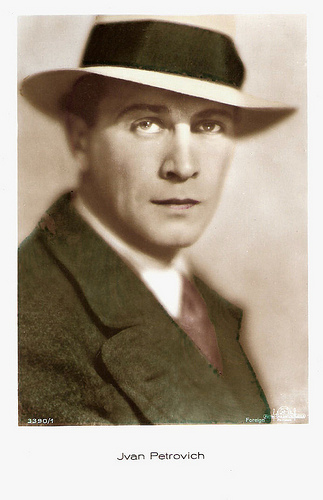
British postcard by Ross Verlag, no. 3390/1, 1928-1929. Photo: Metro-Goldwyn-Mayer.

German postcard by Ross Verlag, Berlin, no. 1454/1, 1927-1928. Photo: Angelo Photos.
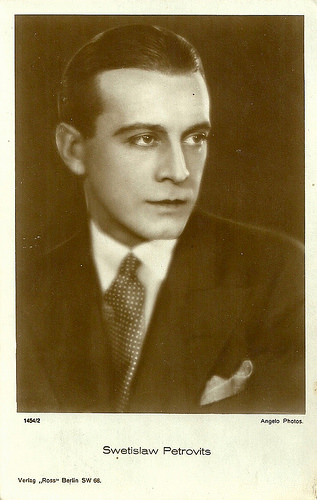
German postcard by Ross Verlag, no. 1454/2. Photo: Angelo. Petrovich is mentioned under his original name Svetislav Petrovic, here in Germanized version.
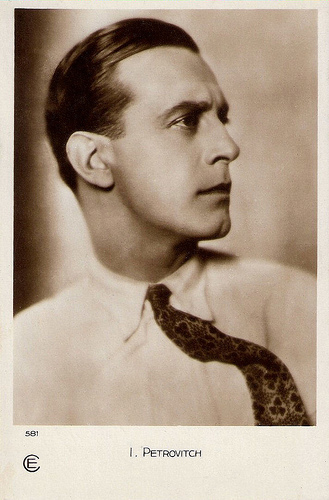
French postcard by Cinémagazine-Edition, Paris, no. 581.
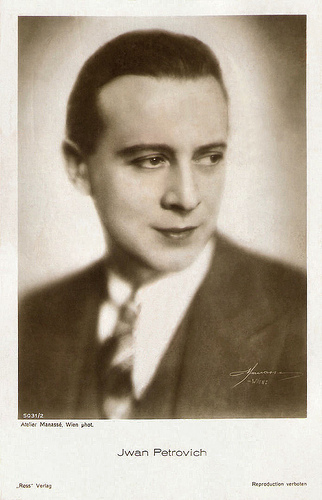
German postcard by Ross Verlag, no. 5031/2, 1930-1931. Photo: Atelier Manassé, Wien.

British postcard by Ross Verlag, no. 3538/1. Photo: Metro-Goldwyn-Mayer. Publicity still for The Garden of Allah (Rex Ingram, 1927).
Michael Curtiz
Iván Petrovich was born as Svetislav Petrovic (Иван Петровић) in Újvidék, Austria-Hungary, today Novi Sad in the Serbian province of Vojvodina, in 1894. He grew up in the bilingual Vojvodina. His names are also spelled Swetislaw, Iwan or Jwan. His father Mladen was a tailor.
After attending the gymnasium in Novi Sad, Petrovich studied engineering at the polytechnic in Prague and later in Belgrade.
He was a talented singer and violinist and was an accomplished athlete, who participated as a swimmer at the 1912 Summer Olympics in Stockholm, Sweden.
In 1916 he had to interrupt his studies when he was called up for the army in Serbia. During World War I he was drafted into the Austro-Hungarian army.
At the end of the First World War he did not return to his studies, but began a career in show business. The handsome and elegant Petrovich worked on stage as a singer and started to appear in silent films, credited as Petrovics Szvetiszláv.
To his early work belong Hungarian films as A Napraforgós hölgy/The Sunflower Woman (Mihály Kertész, later known as Michael Curtiz, 1918) starring Lucy Doraine , the expressionistic Homo immanis/The Horrible Man (Paul Czinner, 1919), and Lengyelvér/Polish Blood (Béla Balogh, 1920).
He had an obvious talent for languages and spoke next to his mother language Serbian also German, English and French.
For Sascha Film in Vienna, he appeared in Die Dame mit dem schwarzen Handschuh/The Lady with the Black Gloves (Mihály Kertész/Michael Curtiz, 1919) and Der Stern von Damaskus/The Star of Damascus (Mihály Kertész/Michael Curtiz, 1920), both starring Lucy Doraine .

Hungarian postcard by City Kindasa. Photo: Angelo Fotografia.
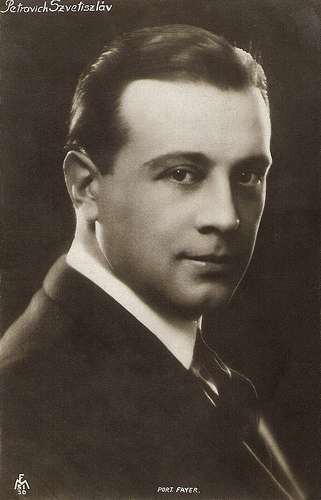
Vintage postcard by FMSI, no. 30. Photo: Port. Fayer.

British postcard in the Picturegoer series, London, no. 287.

French postcard by Cinémagazine-Edition, no. 132. Photo: publicity still for The Magician (Rex Ingram, 1926).

German postcard by Ross Verlag, no. 1454/3, 1927-1928. Photo: Angelo Photos.
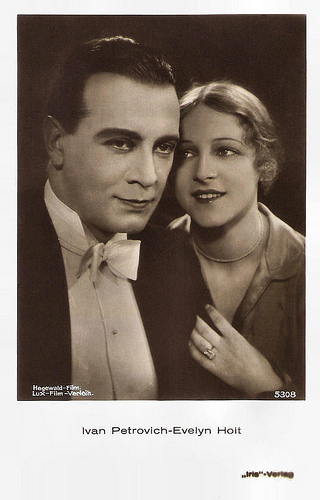
Austrian postcard by Iris Verlag, no. 5308. Photo: Hegewald-Film / Lux-Film-Verleih. Publicity still for Frauenarzt Dr. Schäfer/Gynecologist Doctor Schaefer (Jacob Fleck, Luise Fleck, 1928).

Austrian postcard by Iris Verlag, no. 5314. Photo: Pholbus Film.
The most cherished lover of the French cinema
For a while Iván Petrovich lived in Paris where he worked as an opera singer. His singing talent lead to tours through Europe and the US.
From 1923 on he also appeared in French productions like Un coquin/A Rascal (Giuseppe Guarino, 1923) opposite Arlette Marchal , Koenigsmark/The Secret Spring (Léonce Perret, 1923), and Âme d'artiste/Heart of an Actress (Germaine Dulac, 1924) with Nicolas Koline .
Petrovich was noticed by Hollywood director Rex Ingram who at the time lived and worked in Southern France, where he established a studio in Nice. He actred in three films by Ingram: The Magician (Rex Ingram, 1926), The Garden of Allah (Rex Ingram, 1927) and the lost film The Three Passions (Rex Ingram, 1928) . In all three films he co-starred with Ingram's wife, Alice Terry.
Hal Erickson at AllMovie on The Magician: "The film's literally explosive climax could not help but have influenced such future horror classics as The Bride of Frankenstein, though The Magician is itself less horrific than sensual, especially in the scene where Haddo convinces the hypnotized heroine that she is taking a journey into Hell. Dismissed as 'tasteless' by critics in 1926, The Magician remains one of director Rex Ingram's most fascinating films; alas, most currently available prints are dupes, robbing the film of its original visual magnificence. Among Ingram's talented assistants on this film were future directors Harry Lachman and Michael Powell."
According to Wikipedia, Petrovich was styled “the most cherished lover of the French cinema”. Petrovich was even considered as one of the potential successors of Rudolf Valentino, who had died prematurely in 1926. Petrovich starred in The Sheik-like Arabian adventure Geheimnisse des Orients/Secrets of the Orient (Alexandre Volkoff, 1928) with Nicolas Koline and Marcella Albani .
Among his best known silent films are also La femme nue/The Naked Woman (Léonce Perret, 1926) with Louise Lagrange and Nita Naldi, the fantasy film Alraune/Mandrake (Henrik Galeen, 1928) opposite Brigitte Helm and Paul Wegener.
In 1928 he visited his birthplace Novi Sad back to visit his parents and sisters, and the local news paper Politika published the news on the front page. Petrovich was enthusiastically welcomed by tens of thousands citizens. He was also received by King Alexander I of Yugoslavia who presented him with the Order of St. Sava for his contribution to the popularisation of film art.

Austrian postcard by Iris Verlag, no. 5406. Photo: Hegewald-Film / Lux Film-Vertrieb. This card could be for the Hegewald production Der Orlow (Jakob & Luise Fleck, 1927).

Austrian postcard by Iris Verlag, no. 5785. Photo: Lux Film Verleih / Hegewald Film.

French postcard by Film Europe, no. 367. Photo: Hegewald Film. Publicity still for Der Orlow (Jakob & Luise Fleck, 1927).
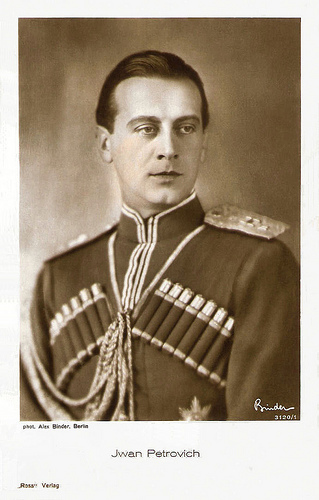
German postcard by Ross Verlag, no. 3120/1, 1928-1929. Photo: Alex Binder. Publicity still for Der Orlow/Prince Orloff (Jacob Fleck, Luise Fleck, 1927).

Austrian postcard by Iris Verlag, no. 5120. Photo: Hegewald Film, Lux Film-Verleih. Ivan Petrovich and Vivian Gibson in Der Orlow/Prince Orloff (Jakob & Luise Fleck, 1927).
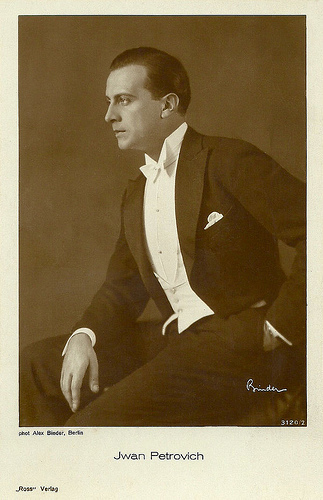
German postcard by Ross Verlag, no. 3120/2, 1928-1929. Photo: Alex Binder, Berlin. Collection: Didier Hanson.
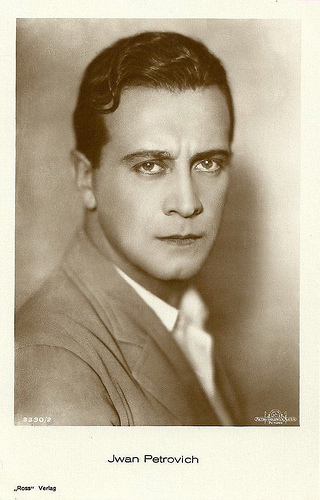
German postcard by Ross Verlag, no. 3390/2, 1928-1929. Photo: Metro-Goldwyn-Mayer.

German postcard by Ross Verlag, no. 3538/1, 1928-1929. Ivan Petrovich and Alice Terry in the MGM production The Garden of Allah (Rex Ingram, 1927).
Tall, handsome and good looking, with a sonorous voice
Thanks to his singing talent, Iván Petrovich made a successful transition into sound film. Tall, handsome and good looking, with a sonorous voice, he even prospered. He expanded his acting range to character roles, like aristocrats, noblemen, officers and priests, in the 'Slavic charm' manner.
However, even though he was multilingual, Petrovich' bad English accent turned out to be an insurmountable obstacle, so he had to scrap his Hollywood plans and he focused on the German cinema. He made some 40 films in Germany till the outbreak of the war. As a good singer, he was frequently cast in filmed operettas.
To his well-known film operettas of the early 1930s belong Viktoria und ihr Husar/Victoria and Her Hussar (Richard Oswald, 1931) opposite his future wife Friedel Schuster, Die Fledermaus/The Bat (Carl Lamac, 1931) with Anny Ondra , and Die Blume von Hawaii/Flower of Hawaii (Richard Oswald, 1933) with Márta Eggerth .
Among his other German films of the 1930s are Das Frauenparadies/Women's Paradise (Arthur Maria Rabenalt, 1936), and Die Nacht der Entscheidung/Night of Fate (Nunzio Malasomma, 1938) with Pola Negri .
After the World War II began, Petrovich continued to act in light entertainment films. He stayed in touch with Serbian issues by visiting his friends, captured Serbian officers, in Nazi camps, which caused him problems with the Nazi Security Service. After being pressured to participate in propaganda film Feinde/Enemies (Viktor Tourjansky, 1940), which tried to justify German occupation of Poland, Petrovich migrated to Hungary.
In Hungary Petrovich appeared in films like Európa nem válaszol/Europe Doesn´t Answer (Géza von Radványi, 1941), Életre ítéltek! (Endre Rodríguez, 1941) with Pál Jávor , and Magdolna (Kálmán Nádasdy, 1942), credited as Petrovics Szvetiszláv.
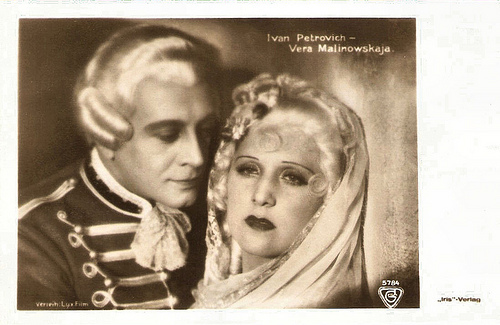
Austrian postcard by Iris Verlag, no. 5784. Photo: Lux Film. Publicity still for Der Günstling von Schönbrunn/Favorite of Schonbrunn (Erich Waschneck, Max Reichmann, 1929) with Vera Malinovskaya .
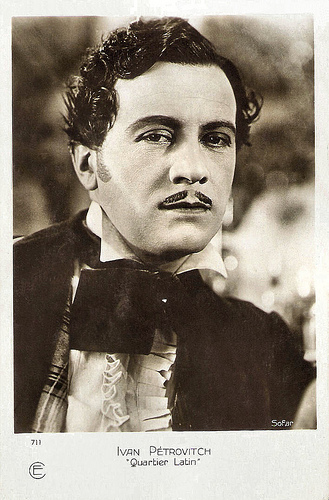
French postcard by Cinémagazine-Edition, no. 711. Photo: Sofar. Publicity still for Quartier Latin (Augusto Genina, 1929).

French postcard by Europe, no. 368. Photo: Hegewald Film. Publicity still for the German film Der Zarewitsch (Jakob & Luise Fleck, 1929), starring Iván Petrovich as the son of czar Peter the Great (Albert Steinrück). The film was an adaption of the operetta by Franz Léhar and the play by Gabriela Zapolska.
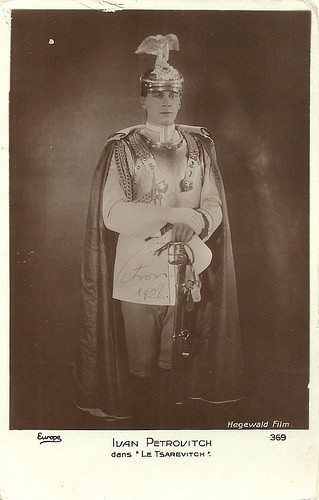
French postcard by Europe, no. 369. Photo: Hegewald Film. Publicity still for Der Zarewitsch (Jakob & Luise Fleck, 1929).
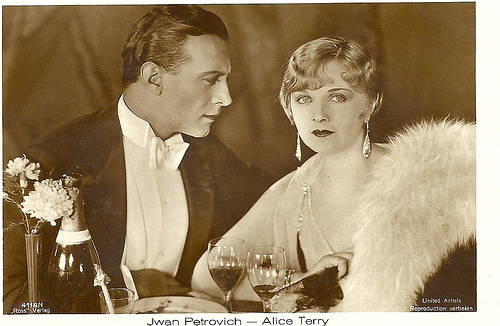
German postcard by Ross Verlag, no. 4118/1, 1929-1930. Photo: United Artists. Ivan Petrovich and Alice Terry in The Three Passions (Rex Ingram, 1929). Collection: Didier Hanson.
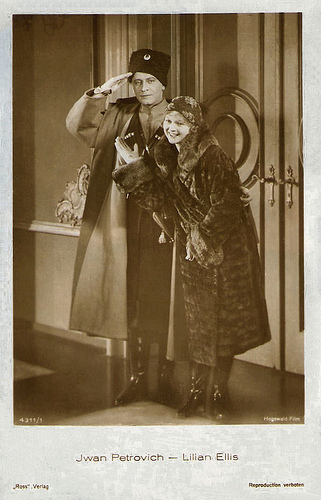
German postcard by Ross Verlag, no. 4311/1, 1929-1930. Photo: Hegewald-Film. Publicity still for Der Leutnant Ihrer Majestät/Court Scandal (Jacob Fleck, Luise Fleck, 1929) with Lillian Ellis.
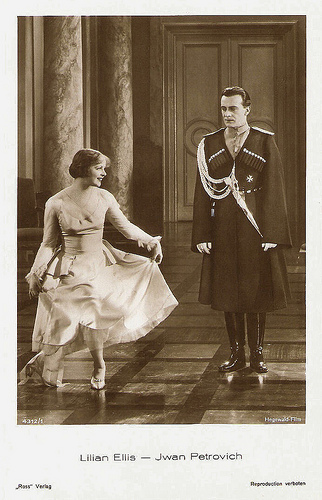
German postcard by Ross Verlag, no. 4312/1, 1929-1930. Photo: Hegewald-Film. Publicity still for Der Leutnant Ihrer Majestät/Court Scandal (Jacob Fleck, Luise Fleck, 1929) with Lillian Ellis.
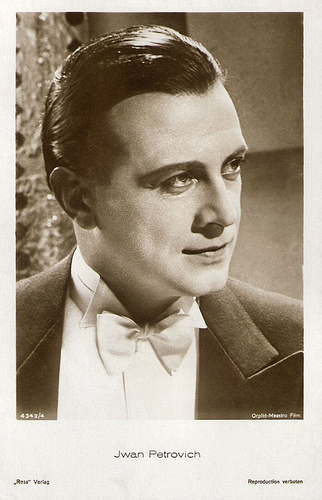
German postcard by Ross Verlag, no. 4343/4, 1929-1930. Photo: Orplid-Messtro Film. Publicity still for Quartier Latin (Augusto Genina, 1929).
Sissi
After the war ended and Communist government was set in Hungary, Iván Petrovich moved back to Germany. In the next 15 years he mostly played supporting roles, and remained a sought actor in the German-speaking countries.
He played supporting parts in German films like Der Prozeß/The Trial (Georg Wilhelm Pabst, 1948) with Ewald Balser, Ludwig von Beethoven’s biopic Eroica (Walter Kolm-Veltée, 1949), and Die Försterchristl/The Forester's Daughter (Arthur Maria Rabenalt, 1952) featuring Johanna Matz .
Petrovich also played a supporting part in the American thriller The Devil Makes Three (Andrew Marton, 1952), starring Gene Kelly and Pier Angeli , which was partly filmed in Germany
He appeared as Dr. Max Falk in the box-office hit Sissi - Die junge Kaiserin/Sissi: The Young Empress (Ernst Marischka, 1956) starring Romy Schneider . The second in the film trilogy about Elisabeth of Austria, the film chronicles the married life of the young empress nicknamed Sissi.
Among his last parts were roles in the classic French thriller Ascenseur pour l'échafaud/Elevator to the Gallows (Louis Malle, 1958) starring Jeanne Moreau and Maurice Ronet, and in Anatole Litvak’s The Journey (1959) about a group of Westerners, who tries to flee Hungary after the Soviet Union moves to crush the Hungarian Revolution of 1956.
Iván Petrovich died of stomach cancer in 1962 in Munich, West Germany. He is interred in the city’s Nordfriedhof cemetery. Petrovich was married to Lilian Hübner and to actress and singer Friedel Schuster.
Apart from acting, in this period he also worked as a radio announcer on Radio Free Europe, which was headquartered in Munich at the time. His work was strongly disliked by the post-war Communist authorities of Yugoslavia. Wikipedia writes that this is one of the reasons why Petrovich is largely forgotten in Serbia today. In an effort to change that, the Serbian national film library, Jugoslovenska kinoteka, dedicated the year 2017 to him, and shows his films throughout the whole year.
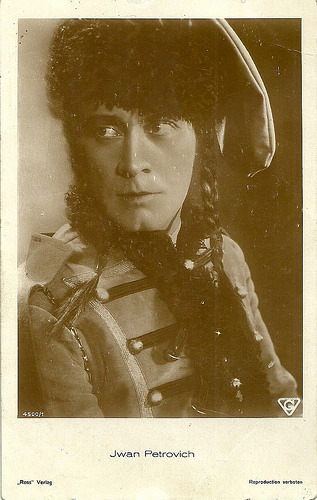
German postcard by Ross Verlag, no. 4500/1, 1929-1930. Photo: G [Greenbaum-Film]. Publicity still for Der Günstling von Schönbrunn (Erich Waschneck, Max Reichmann, 1929), in which Petrovich plays the favourite of empress Maria Theresia ( Lil Dagover ). As the film was shot during the sound film breakthrough, both a silent and a sound film were made.
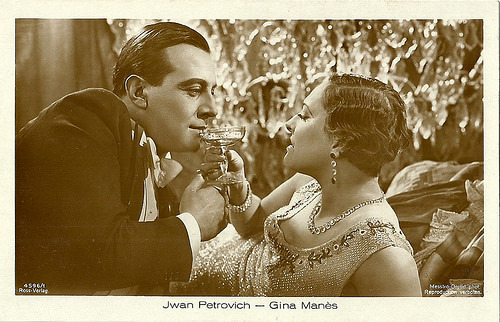
German postcard by Ross Verlag, no. 4596/1, 1929-1930. Photo Messtro-Orplid. Ivan Petrovich and Gina Manès in Quartier Latin (Augusto Genina, 1929).
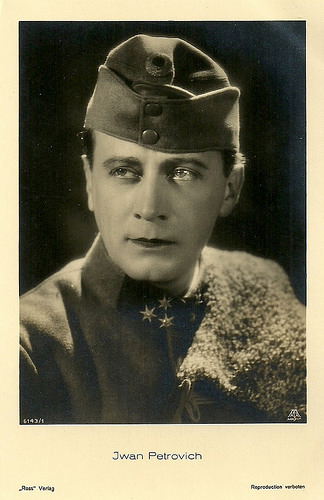
German postcard by Ross Verlag, no. 6143/1, 1931-1932. Photo: Aafa.
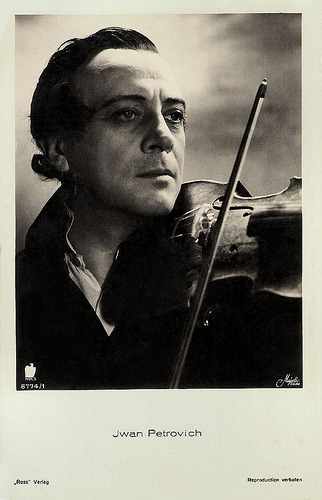
German postcard by Ross Verlag, no. 8774/1, 1933-1934. Photo: Majestic-Film / NDLS. Publicity still for Gern hab' ich die Frau'n geküßt /Paganini (E.W. Emo, 1934) with Iván Petrovich as the most celebrated violin virtuoso of his time, Niccolò Paganini (1782-1840).
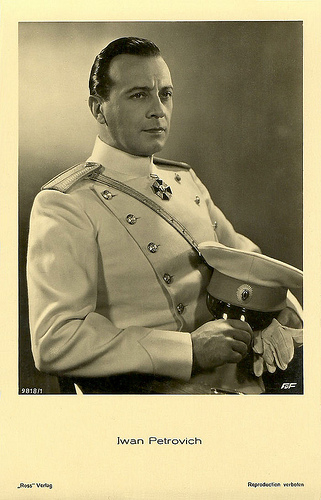
German postcard by Ross Verlag, no. 9818/1, 1935-1936. Photo: FoF. Collection: Didier Hanson.
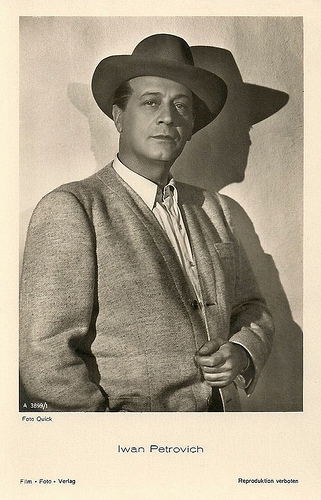
German postcard by Film-Foto-Verlag, no. A 3899/1, 1941-1944. Photo: Quick.
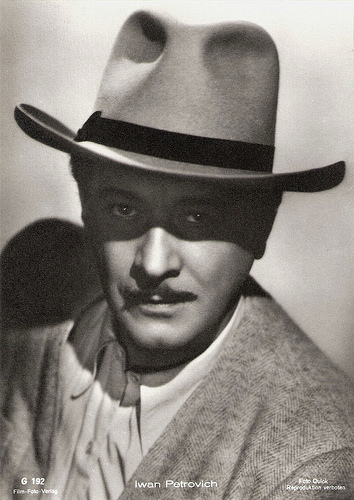
German postcard by Film-Foto-Verlag, no. G 192, 1941-1944. Photo: Quick.
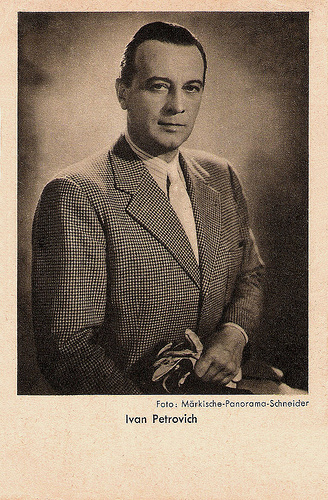
German postcard by Das Programm von Heute, Berlin. Photo: Märkische / Panorama / Schneider. Collection: Miss Mertens.
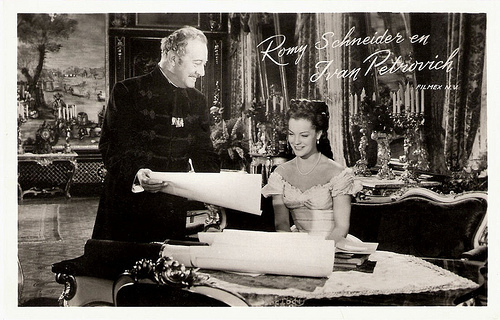
Dutch postcard by Takken, no. AX 3028. Photo: Filmex N.V. Publicity still for Sissi - Die junge Kaiserin/Sissi: The Young Empress (Ernst Marischka, 1956) starring Romy Schneider .
Trailer The Garden Of Allah (1927). Source: perfectjazz78 (YouTube).
Scene from Viktoria und ihr Husar/Victoria and Her Hussar (1931) with Friedel Schuster singing Rote Orchideen (Red Orchids). It was Schuster's film debut. Source: Alparfan (YouTube).
Ivan Petrovich sings Das Zigarettenlied in Der Orlow (1932). Source: Alparfan (YouTube).
Sources: Hal Erickson (AllMovie), Thomas Staedeli (Cyranos), Wikipedia (English, Serbian and German), and .

British postcard by Ross Verlag, no. 3390/1, 1928-1929. Photo: Metro-Goldwyn-Mayer.

German postcard by Ross Verlag, Berlin, no. 1454/1, 1927-1928. Photo: Angelo Photos.

German postcard by Ross Verlag, no. 1454/2. Photo: Angelo. Petrovich is mentioned under his original name Svetislav Petrovic, here in Germanized version.

French postcard by Cinémagazine-Edition, Paris, no. 581.

German postcard by Ross Verlag, no. 5031/2, 1930-1931. Photo: Atelier Manassé, Wien.

British postcard by Ross Verlag, no. 3538/1. Photo: Metro-Goldwyn-Mayer. Publicity still for The Garden of Allah (Rex Ingram, 1927).
Michael Curtiz
Iván Petrovich was born as Svetislav Petrovic (Иван Петровић) in Újvidék, Austria-Hungary, today Novi Sad in the Serbian province of Vojvodina, in 1894. He grew up in the bilingual Vojvodina. His names are also spelled Swetislaw, Iwan or Jwan. His father Mladen was a tailor.
After attending the gymnasium in Novi Sad, Petrovich studied engineering at the polytechnic in Prague and later in Belgrade.
He was a talented singer and violinist and was an accomplished athlete, who participated as a swimmer at the 1912 Summer Olympics in Stockholm, Sweden.
In 1916 he had to interrupt his studies when he was called up for the army in Serbia. During World War I he was drafted into the Austro-Hungarian army.
At the end of the First World War he did not return to his studies, but began a career in show business. The handsome and elegant Petrovich worked on stage as a singer and started to appear in silent films, credited as Petrovics Szvetiszláv.
To his early work belong Hungarian films as A Napraforgós hölgy/The Sunflower Woman (Mihály Kertész, later known as Michael Curtiz, 1918) starring Lucy Doraine , the expressionistic Homo immanis/The Horrible Man (Paul Czinner, 1919), and Lengyelvér/Polish Blood (Béla Balogh, 1920).
He had an obvious talent for languages and spoke next to his mother language Serbian also German, English and French.
For Sascha Film in Vienna, he appeared in Die Dame mit dem schwarzen Handschuh/The Lady with the Black Gloves (Mihály Kertész/Michael Curtiz, 1919) and Der Stern von Damaskus/The Star of Damascus (Mihály Kertész/Michael Curtiz, 1920), both starring Lucy Doraine .

Hungarian postcard by City Kindasa. Photo: Angelo Fotografia.

Vintage postcard by FMSI, no. 30. Photo: Port. Fayer.

British postcard in the Picturegoer series, London, no. 287.

French postcard by Cinémagazine-Edition, no. 132. Photo: publicity still for The Magician (Rex Ingram, 1926).

German postcard by Ross Verlag, no. 1454/3, 1927-1928. Photo: Angelo Photos.

Austrian postcard by Iris Verlag, no. 5308. Photo: Hegewald-Film / Lux-Film-Verleih. Publicity still for Frauenarzt Dr. Schäfer/Gynecologist Doctor Schaefer (Jacob Fleck, Luise Fleck, 1928).

Austrian postcard by Iris Verlag, no. 5314. Photo: Pholbus Film.
The most cherished lover of the French cinema
For a while Iván Petrovich lived in Paris where he worked as an opera singer. His singing talent lead to tours through Europe and the US.
From 1923 on he also appeared in French productions like Un coquin/A Rascal (Giuseppe Guarino, 1923) opposite Arlette Marchal , Koenigsmark/The Secret Spring (Léonce Perret, 1923), and Âme d'artiste/Heart of an Actress (Germaine Dulac, 1924) with Nicolas Koline .
Petrovich was noticed by Hollywood director Rex Ingram who at the time lived and worked in Southern France, where he established a studio in Nice. He actred in three films by Ingram: The Magician (Rex Ingram, 1926), The Garden of Allah (Rex Ingram, 1927) and the lost film The Three Passions (Rex Ingram, 1928) . In all three films he co-starred with Ingram's wife, Alice Terry.
Hal Erickson at AllMovie on The Magician: "The film's literally explosive climax could not help but have influenced such future horror classics as The Bride of Frankenstein, though The Magician is itself less horrific than sensual, especially in the scene where Haddo convinces the hypnotized heroine that she is taking a journey into Hell. Dismissed as 'tasteless' by critics in 1926, The Magician remains one of director Rex Ingram's most fascinating films; alas, most currently available prints are dupes, robbing the film of its original visual magnificence. Among Ingram's talented assistants on this film were future directors Harry Lachman and Michael Powell."
According to Wikipedia, Petrovich was styled “the most cherished lover of the French cinema”. Petrovich was even considered as one of the potential successors of Rudolf Valentino, who had died prematurely in 1926. Petrovich starred in The Sheik-like Arabian adventure Geheimnisse des Orients/Secrets of the Orient (Alexandre Volkoff, 1928) with Nicolas Koline and Marcella Albani .
Among his best known silent films are also La femme nue/The Naked Woman (Léonce Perret, 1926) with Louise Lagrange and Nita Naldi, the fantasy film Alraune/Mandrake (Henrik Galeen, 1928) opposite Brigitte Helm and Paul Wegener.
In 1928 he visited his birthplace Novi Sad back to visit his parents and sisters, and the local news paper Politika published the news on the front page. Petrovich was enthusiastically welcomed by tens of thousands citizens. He was also received by King Alexander I of Yugoslavia who presented him with the Order of St. Sava for his contribution to the popularisation of film art.

Austrian postcard by Iris Verlag, no. 5406. Photo: Hegewald-Film / Lux Film-Vertrieb. This card could be for the Hegewald production Der Orlow (Jakob & Luise Fleck, 1927).

Austrian postcard by Iris Verlag, no. 5785. Photo: Lux Film Verleih / Hegewald Film.

French postcard by Film Europe, no. 367. Photo: Hegewald Film. Publicity still for Der Orlow (Jakob & Luise Fleck, 1927).

German postcard by Ross Verlag, no. 3120/1, 1928-1929. Photo: Alex Binder. Publicity still for Der Orlow/Prince Orloff (Jacob Fleck, Luise Fleck, 1927).

Austrian postcard by Iris Verlag, no. 5120. Photo: Hegewald Film, Lux Film-Verleih. Ivan Petrovich and Vivian Gibson in Der Orlow/Prince Orloff (Jakob & Luise Fleck, 1927).

German postcard by Ross Verlag, no. 3120/2, 1928-1929. Photo: Alex Binder, Berlin. Collection: Didier Hanson.

German postcard by Ross Verlag, no. 3390/2, 1928-1929. Photo: Metro-Goldwyn-Mayer.

German postcard by Ross Verlag, no. 3538/1, 1928-1929. Ivan Petrovich and Alice Terry in the MGM production The Garden of Allah (Rex Ingram, 1927).
Tall, handsome and good looking, with a sonorous voice
Thanks to his singing talent, Iván Petrovich made a successful transition into sound film. Tall, handsome and good looking, with a sonorous voice, he even prospered. He expanded his acting range to character roles, like aristocrats, noblemen, officers and priests, in the 'Slavic charm' manner.
However, even though he was multilingual, Petrovich' bad English accent turned out to be an insurmountable obstacle, so he had to scrap his Hollywood plans and he focused on the German cinema. He made some 40 films in Germany till the outbreak of the war. As a good singer, he was frequently cast in filmed operettas.
To his well-known film operettas of the early 1930s belong Viktoria und ihr Husar/Victoria and Her Hussar (Richard Oswald, 1931) opposite his future wife Friedel Schuster, Die Fledermaus/The Bat (Carl Lamac, 1931) with Anny Ondra , and Die Blume von Hawaii/Flower of Hawaii (Richard Oswald, 1933) with Márta Eggerth .
Among his other German films of the 1930s are Das Frauenparadies/Women's Paradise (Arthur Maria Rabenalt, 1936), and Die Nacht der Entscheidung/Night of Fate (Nunzio Malasomma, 1938) with Pola Negri .
After the World War II began, Petrovich continued to act in light entertainment films. He stayed in touch with Serbian issues by visiting his friends, captured Serbian officers, in Nazi camps, which caused him problems with the Nazi Security Service. After being pressured to participate in propaganda film Feinde/Enemies (Viktor Tourjansky, 1940), which tried to justify German occupation of Poland, Petrovich migrated to Hungary.
In Hungary Petrovich appeared in films like Európa nem válaszol/Europe Doesn´t Answer (Géza von Radványi, 1941), Életre ítéltek! (Endre Rodríguez, 1941) with Pál Jávor , and Magdolna (Kálmán Nádasdy, 1942), credited as Petrovics Szvetiszláv.

Austrian postcard by Iris Verlag, no. 5784. Photo: Lux Film. Publicity still for Der Günstling von Schönbrunn/Favorite of Schonbrunn (Erich Waschneck, Max Reichmann, 1929) with Vera Malinovskaya .

French postcard by Cinémagazine-Edition, no. 711. Photo: Sofar. Publicity still for Quartier Latin (Augusto Genina, 1929).

French postcard by Europe, no. 368. Photo: Hegewald Film. Publicity still for the German film Der Zarewitsch (Jakob & Luise Fleck, 1929), starring Iván Petrovich as the son of czar Peter the Great (Albert Steinrück). The film was an adaption of the operetta by Franz Léhar and the play by Gabriela Zapolska.

French postcard by Europe, no. 369. Photo: Hegewald Film. Publicity still for Der Zarewitsch (Jakob & Luise Fleck, 1929).

German postcard by Ross Verlag, no. 4118/1, 1929-1930. Photo: United Artists. Ivan Petrovich and Alice Terry in The Three Passions (Rex Ingram, 1929). Collection: Didier Hanson.

German postcard by Ross Verlag, no. 4311/1, 1929-1930. Photo: Hegewald-Film. Publicity still for Der Leutnant Ihrer Majestät/Court Scandal (Jacob Fleck, Luise Fleck, 1929) with Lillian Ellis.

German postcard by Ross Verlag, no. 4312/1, 1929-1930. Photo: Hegewald-Film. Publicity still for Der Leutnant Ihrer Majestät/Court Scandal (Jacob Fleck, Luise Fleck, 1929) with Lillian Ellis.

German postcard by Ross Verlag, no. 4343/4, 1929-1930. Photo: Orplid-Messtro Film. Publicity still for Quartier Latin (Augusto Genina, 1929).
Sissi
After the war ended and Communist government was set in Hungary, Iván Petrovich moved back to Germany. In the next 15 years he mostly played supporting roles, and remained a sought actor in the German-speaking countries.
He played supporting parts in German films like Der Prozeß/The Trial (Georg Wilhelm Pabst, 1948) with Ewald Balser, Ludwig von Beethoven’s biopic Eroica (Walter Kolm-Veltée, 1949), and Die Försterchristl/The Forester's Daughter (Arthur Maria Rabenalt, 1952) featuring Johanna Matz .
Petrovich also played a supporting part in the American thriller The Devil Makes Three (Andrew Marton, 1952), starring Gene Kelly and Pier Angeli , which was partly filmed in Germany
He appeared as Dr. Max Falk in the box-office hit Sissi - Die junge Kaiserin/Sissi: The Young Empress (Ernst Marischka, 1956) starring Romy Schneider . The second in the film trilogy about Elisabeth of Austria, the film chronicles the married life of the young empress nicknamed Sissi.
Among his last parts were roles in the classic French thriller Ascenseur pour l'échafaud/Elevator to the Gallows (Louis Malle, 1958) starring Jeanne Moreau and Maurice Ronet, and in Anatole Litvak’s The Journey (1959) about a group of Westerners, who tries to flee Hungary after the Soviet Union moves to crush the Hungarian Revolution of 1956.
Iván Petrovich died of stomach cancer in 1962 in Munich, West Germany. He is interred in the city’s Nordfriedhof cemetery. Petrovich was married to Lilian Hübner and to actress and singer Friedel Schuster.
Apart from acting, in this period he also worked as a radio announcer on Radio Free Europe, which was headquartered in Munich at the time. His work was strongly disliked by the post-war Communist authorities of Yugoslavia. Wikipedia writes that this is one of the reasons why Petrovich is largely forgotten in Serbia today. In an effort to change that, the Serbian national film library, Jugoslovenska kinoteka, dedicated the year 2017 to him, and shows his films throughout the whole year.

German postcard by Ross Verlag, no. 4500/1, 1929-1930. Photo: G [Greenbaum-Film]. Publicity still for Der Günstling von Schönbrunn (Erich Waschneck, Max Reichmann, 1929), in which Petrovich plays the favourite of empress Maria Theresia ( Lil Dagover ). As the film was shot during the sound film breakthrough, both a silent and a sound film were made.

German postcard by Ross Verlag, no. 4596/1, 1929-1930. Photo Messtro-Orplid. Ivan Petrovich and Gina Manès in Quartier Latin (Augusto Genina, 1929).

German postcard by Ross Verlag, no. 6143/1, 1931-1932. Photo: Aafa.

German postcard by Ross Verlag, no. 8774/1, 1933-1934. Photo: Majestic-Film / NDLS. Publicity still for Gern hab' ich die Frau'n geküßt /Paganini (E.W. Emo, 1934) with Iván Petrovich as the most celebrated violin virtuoso of his time, Niccolò Paganini (1782-1840).

German postcard by Ross Verlag, no. 9818/1, 1935-1936. Photo: FoF. Collection: Didier Hanson.

German postcard by Film-Foto-Verlag, no. A 3899/1, 1941-1944. Photo: Quick.

German postcard by Film-Foto-Verlag, no. G 192, 1941-1944. Photo: Quick.

German postcard by Das Programm von Heute, Berlin. Photo: Märkische / Panorama / Schneider. Collection: Miss Mertens.

Dutch postcard by Takken, no. AX 3028. Photo: Filmex N.V. Publicity still for Sissi - Die junge Kaiserin/Sissi: The Young Empress (Ernst Marischka, 1956) starring Romy Schneider .
Trailer The Garden Of Allah (1927). Source: perfectjazz78 (YouTube).
Scene from Viktoria und ihr Husar/Victoria and Her Hussar (1931) with Friedel Schuster singing Rote Orchideen (Red Orchids). It was Schuster's film debut. Source: Alparfan (YouTube).
Ivan Petrovich sings Das Zigarettenlied in Der Orlow (1932). Source: Alparfan (YouTube).
Sources: Hal Erickson (AllMovie), Thomas Staedeli (Cyranos), Wikipedia (English, Serbian and German), and .
Published on July 27, 2017 22:00
July 26, 2017
Grete Weixler
Grete Weixler (ca. 1900 - after 1922) was a German actress of the silent cinema. From 1914 on, she appeared in secondary roles in melodramas by directors like Carl Boese, Friedrich Zelnik and Lupu Pick.
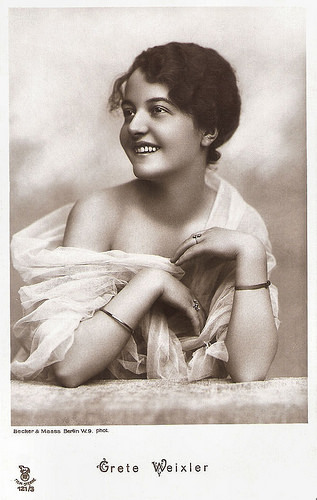
German postcard in the Film Sterne series by Rotophot, no. 121/3. Photo: Becker & Maass, Berlin.
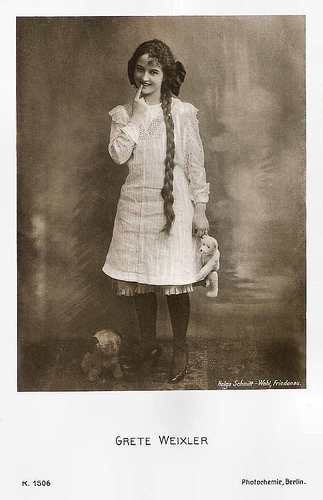
German postcard in Photochemie, Berlin, no. K 1324. Photo: Helga-Schmitt-Wehl, Friedenau.
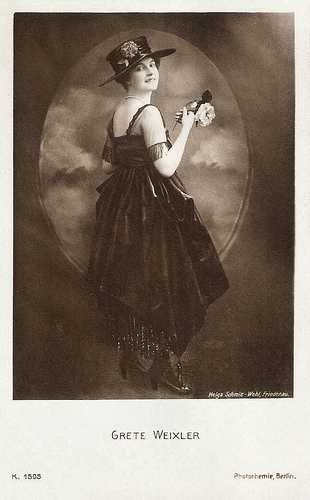
German postcard by Photochemie, Berlin, no. K 1505. Photo: Helga Schmitt-Wehl, Friedenau.
The story of a fallen woman
Grete Weixler was born into an actor’s family. Her grandfather had been successful in Hungary as an actor, Weixler's aunt lived as an artist in Vienna. Weixler's other siblings also turned to the performing arts.
Best known is her elder sister, popular silent film actress Dorrit Weixler . Grete followed in her footsteps and made her film debut under the direction of Dorrit’s husband, pioneer director Franz Hofer.
Possibly her first film was the silent short Fräulein Piccolo/Miss Piccolo (Franz Hofer, 1914) in which her sister starred and Ernst Lubitsch had a small role. Dorrit Weixler was the first German ‘backfish’, specialised in playing childlike young women in comedies.
In contrast to her sister, Grete Weixler appeared in serious films such as the melodramas Jahreszeiten des Lebens/Seasons of Life (Franz Hofer, 1915), Geopfert .../Sacrificed… (Walter Schmidthässler, 1916), and the Charles Dickens adaptation Klein Doortje/Little Dorrit (Friedrich Zelnik, 1917) featuring Lisa Weise .
Her next films included Margarete. Die Geschichte einer Gefallenen/Margarete. The story of a fallen woman (Friedrich Zelnik, 1918), featuring Lya Mara , and Verschleppt/Abducted (Carl Boese, 1919).
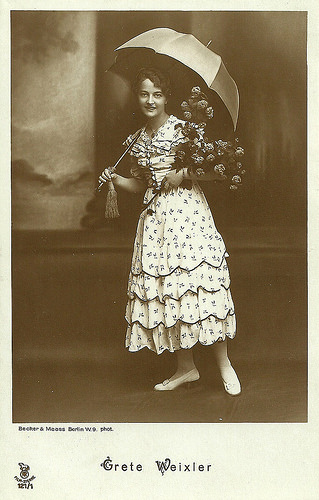
German postcard in the Film Sterne series by Rotophot, no. 121/1. Photo: Becker & Maass, Berlin.
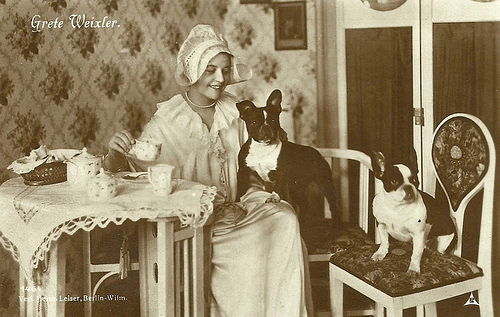
German postcard by Verlag Hermann Leiser, Berlin, no. 1464. Photo: Pm.
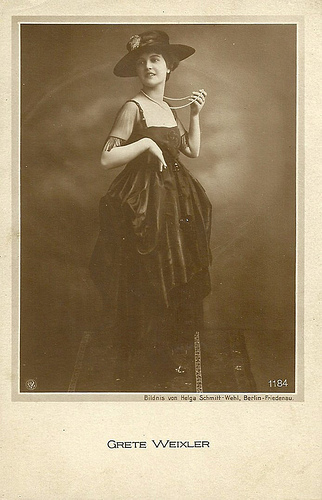
German postcard by NPG, no. 1184. Photo: Helga Schmidt-Wehl, Berlin-Friedenau.
The Way of Condemnation
In 1919, Grete Weixler took over the role of Lilly in Der Weg, der zur Verdammnis führt, 2. Teil. Hyänen der Lust (Otto Rippert, 1919) the second part of the film Der Weg der Verdammnis/The Way of Condemnation, about the fate of two young women who fall in the hands of girl traffickers.
Der Weg der Verdammnis/The Way of Condemnation was one of the most controversial and successful examples of the wave of ‘Sittenfilme’, melodramas about taboo subjects, mostly sexual, which were presented as enlightenment. This film was produced by the Gesellschaft zur Bekämpfung des Mädchenhandels (Society for the Struggle Against White Slavery).
Other films with Grete Weixler were Die Herrenschneiderin/The Lord's Cutler (Lupu Pick, 1919) and Die Sklavenhalter von Kansas-City/The Slaves of Kansas City (Wolfgang Neff, 1920) with a young Béla Lugosi .
In addition to her work in the cinema, Weixler was also a stage actress and appeared in the Trianon-Theater in Berlin. In 1922, she made her final film Die Tochter der Verführten/The Daughter of the seduced (Jaap Speyer, 1922) in which she played the daughter of a banker who falls for a femme fatale ( Mia Pankau ).
What happened to Grete Weixler after her retirement is not known. In 1916 her sister Dorrit, who was a morphine-dependent, had taken her own life.
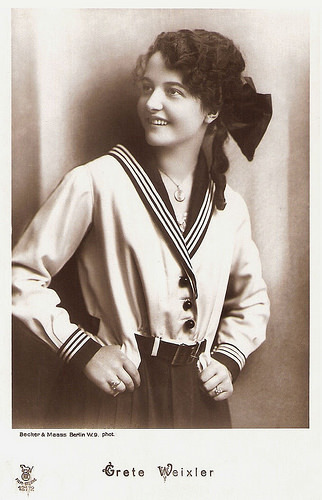
German postcard in the Film Sterne series by Rotophot, no. 121/2. Photo: Becker & Maass, Berlin.
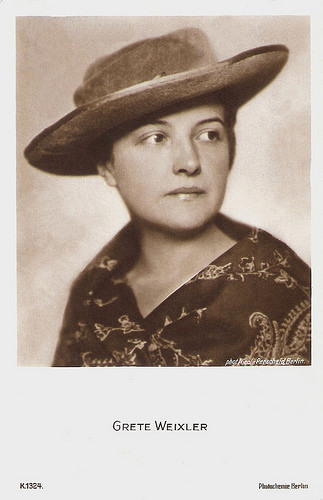
German postcard in Photochemie, Berlin, no. K 1324. Photo: Nicola Perscheid, Berlin.
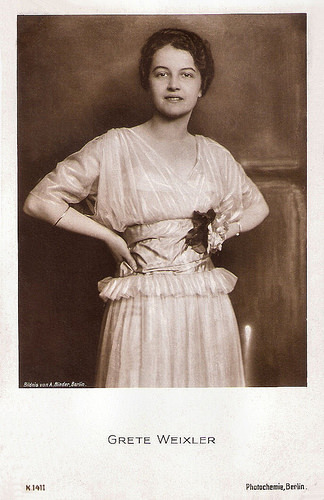
German postcard in Photochemie, Berlin, no. K 1411. Photo: Alex Binder, Berlin.
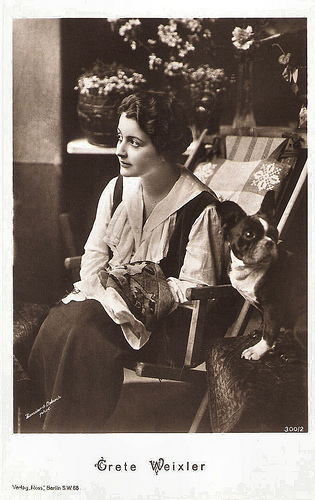
German postcard by Verlag Ross, Berlin, no. 300/2, 1919-1924. Photo: Zander and Labisch.
Sources: Stephanie D’heil (Steffi-Line), Sophie (German), Wikipedia (German) and .

German postcard in the Film Sterne series by Rotophot, no. 121/3. Photo: Becker & Maass, Berlin.

German postcard in Photochemie, Berlin, no. K 1324. Photo: Helga-Schmitt-Wehl, Friedenau.

German postcard by Photochemie, Berlin, no. K 1505. Photo: Helga Schmitt-Wehl, Friedenau.
The story of a fallen woman
Grete Weixler was born into an actor’s family. Her grandfather had been successful in Hungary as an actor, Weixler's aunt lived as an artist in Vienna. Weixler's other siblings also turned to the performing arts.
Best known is her elder sister, popular silent film actress Dorrit Weixler . Grete followed in her footsteps and made her film debut under the direction of Dorrit’s husband, pioneer director Franz Hofer.
Possibly her first film was the silent short Fräulein Piccolo/Miss Piccolo (Franz Hofer, 1914) in which her sister starred and Ernst Lubitsch had a small role. Dorrit Weixler was the first German ‘backfish’, specialised in playing childlike young women in comedies.
In contrast to her sister, Grete Weixler appeared in serious films such as the melodramas Jahreszeiten des Lebens/Seasons of Life (Franz Hofer, 1915), Geopfert .../Sacrificed… (Walter Schmidthässler, 1916), and the Charles Dickens adaptation Klein Doortje/Little Dorrit (Friedrich Zelnik, 1917) featuring Lisa Weise .
Her next films included Margarete. Die Geschichte einer Gefallenen/Margarete. The story of a fallen woman (Friedrich Zelnik, 1918), featuring Lya Mara , and Verschleppt/Abducted (Carl Boese, 1919).

German postcard in the Film Sterne series by Rotophot, no. 121/1. Photo: Becker & Maass, Berlin.

German postcard by Verlag Hermann Leiser, Berlin, no. 1464. Photo: Pm.

German postcard by NPG, no. 1184. Photo: Helga Schmidt-Wehl, Berlin-Friedenau.
The Way of Condemnation
In 1919, Grete Weixler took over the role of Lilly in Der Weg, der zur Verdammnis führt, 2. Teil. Hyänen der Lust (Otto Rippert, 1919) the second part of the film Der Weg der Verdammnis/The Way of Condemnation, about the fate of two young women who fall in the hands of girl traffickers.
Der Weg der Verdammnis/The Way of Condemnation was one of the most controversial and successful examples of the wave of ‘Sittenfilme’, melodramas about taboo subjects, mostly sexual, which were presented as enlightenment. This film was produced by the Gesellschaft zur Bekämpfung des Mädchenhandels (Society for the Struggle Against White Slavery).
Other films with Grete Weixler were Die Herrenschneiderin/The Lord's Cutler (Lupu Pick, 1919) and Die Sklavenhalter von Kansas-City/The Slaves of Kansas City (Wolfgang Neff, 1920) with a young Béla Lugosi .
In addition to her work in the cinema, Weixler was also a stage actress and appeared in the Trianon-Theater in Berlin. In 1922, she made her final film Die Tochter der Verführten/The Daughter of the seduced (Jaap Speyer, 1922) in which she played the daughter of a banker who falls for a femme fatale ( Mia Pankau ).
What happened to Grete Weixler after her retirement is not known. In 1916 her sister Dorrit, who was a morphine-dependent, had taken her own life.

German postcard in the Film Sterne series by Rotophot, no. 121/2. Photo: Becker & Maass, Berlin.

German postcard in Photochemie, Berlin, no. K 1324. Photo: Nicola Perscheid, Berlin.

German postcard in Photochemie, Berlin, no. K 1411. Photo: Alex Binder, Berlin.

German postcard by Verlag Ross, Berlin, no. 300/2, 1919-1924. Photo: Zander and Labisch.
Sources: Stephanie D’heil (Steffi-Line), Sophie (German), Wikipedia (German) and .
Published on July 26, 2017 22:00
July 25, 2017
Carl Clewing
German actor Carl Clewing (1884-1954) was also an opera singer, the composer of the song Alle Tage ist kein Sonntag (Every Day Isn't Sunday) and a music professor in Berlin. During the years of the early cinema he was much in demand as film actor.
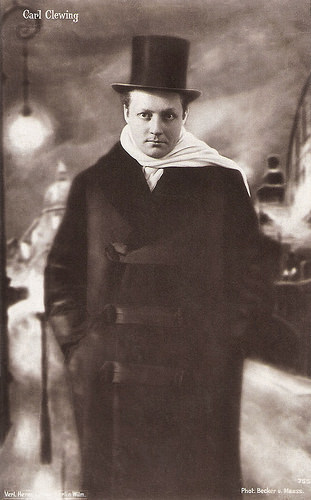
German postcard by Verlag Hermann Leiser, Berlin-Wilm., no. 755. Photo: Becker & Maass, Berlin.
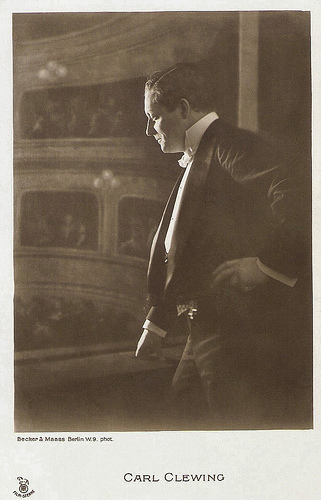
German postcard in the Film Sterne series by Rotophot, no. 147. Photo: Becker & Maass, Berlin.
Ernst Lubitsch classic
Theodor Rudolph Carl Clewing was born in 1884 in Schwerin, Germany. His father was the owner of an apothecary.
Clewing studied in Prague. From 1909 he was an actor in Berlin and he was appointed Royal Court actor in 1911.
In the same year, Clewing also made his debut as a film actor in Der fremde Vogel/The Strange Bird (Urban Gad, 1911) starring Hans Mierendorff and Asta Nielsen .
In the next years followed roles in productions like Ein Sommernachtstraum in unserer Zeit (Stellan Rye, 1913) based on motives of William Shakespeare’s A Midsummer Night's Dream, the fantasy Der Ring des schwedischen Reiters/The ring of the Swedish riders (Stellan Rye, 1913), and Der Flug in die Sonne/The flight into the sun (Stellan Rye, 1914).
At the outbreak of the First World War, he announced himself voluntarily, and during the war he was repeatedly distinguished and promoted to lieutenant.
After the war, he was again active in Berlin as an opera singer, but also as a film actor. Among his films were the crime drama Whitechapel (Ewald André Dupont 1920) with Hans Mierendorff and Grit Hagasa, and Ernst Lubitsch ’s classic Sumurun (1920), in which Ewing played the young Sheik.
His final film was Das Floß der Toten/The raft of the dead (Carl Boese, 1920) with Aud Egede Nissen .
In the autumn of 1922, he had an engagement as 'Heldentenor' at the Staatsoper Berlin. In 1924-1925 he performed at the Bayreuth Festival and sang Walter von Stolzing and the Parsifal.
In 1922 he became a guest lecturer and professor at the State Conservatory of the Hochschule für Staats- & Wirtschaftswissenschaften in Detmold. In December 1928 he was appointed extraordinary professor for singing, vocal training and practical phonetics at the University of Music in Vienna.
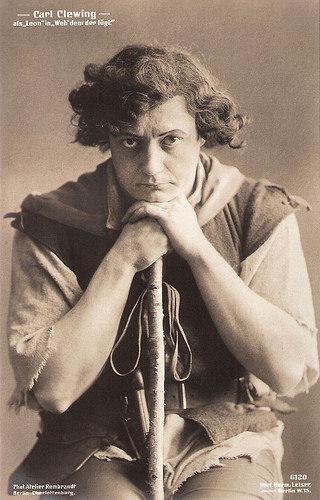
German postcard by Verlag Herm. Leiser, no. 6120. Photo: Atelier Rembrandt, Berlin-Charlottenburg. Publicity still for a stage production of Weh dem, der lügt! by Franz Grillparzer with Carl Clewing in the role of Leon, the kitchen help.
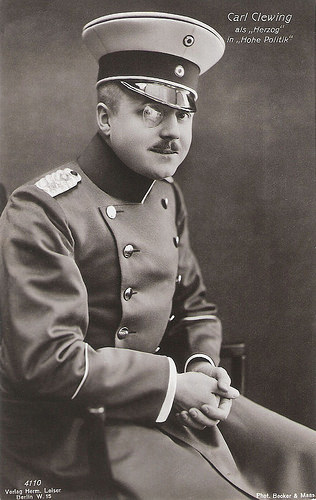
German postcard by Verlag Hermann Leiser, Berlin-Wilm., no. 4110. Photo: Becker & Maass. Publicity still for the stage play Hohe Politik by Julius Rosen.
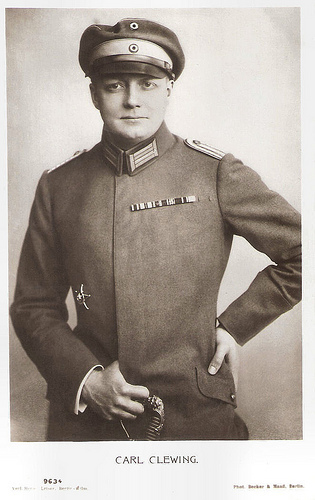
German postcard by Verlag Herm. Leiser, Berlin-Wilm., no. 9634. Photo: Becker & Maass.
A member of the NSDAP, the SA, and the SS
At the beginning of 1931 Carl Clewing moved back to Germany and was appointed professor at the Staatliche Hochschule für Musik in Berlin, and at the same time he was a representative of the Cooperative of German Stage Artists in the School of the German Stage Society, as well as a member of the Berlin Opera and Opera, and moved to Berlin-Lichterfelde-Ost.
After Adolf Hitler's rise to power, Clewing was a member of the NSDAP, the SA, and the SS. However, he was expelled in 1934, because he had concealed his ‘non-Aryan slippage’ and his former affiliation to a Masonic lodge.
In 1935 he composed the Schlager and folk play Alle Tage ist kein Sonntag. It was made into the film Alle Tage ist kein Sonntag/Every Day Isn't Sunday(Walter Janssen, 1935) with Adele Sandrock and Wolfgang Liebeneiner .
In the second half of the 1930s, Clewing, who was also a passionate hunter and collector of hunting culture, was entrusted by Hermann Göring, who was the 'Reichsjägermeister', to issue the series of monuments of German hunting culture. The first volume appeared as early as 1937, as well as a folk edition of 100 huntsmen and a songbook of the Luftwaffe.
During this time he also developed a small form of the Fürst-Pless-Horn, which is also called 'Clewingsches Taschenjagdhorn'.
In May 1939 he returned as an opera singer. In the same year, he wrote a cantata on the birth of Edda Goering.
After the Second World War he lived in the sanatorium in Glotterbad near Freiburg im Breisgau and spent his retirement in the health resort Dr. Saller in Badenweiler. Carl Clewing passed away in Badenweiler, Baden-Württemberg, Germany in 1954.
In 1923, Clewing had married Elisabeth (Else) née Mulert, adopted Arnhold, widowed Kunheim. They divorced in 1940, and had a son, Carl Peter (1924-1943, fallen at Salerno).
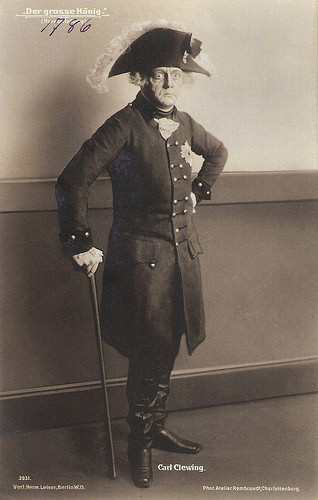
German postcard by Verlag Hermann Leiser, Berlin-Wilm., no. 3931. Photo: Atelier Rembrandt, Charlottenburg. Publicity still for a stage production of Der grosse König (The Great King).
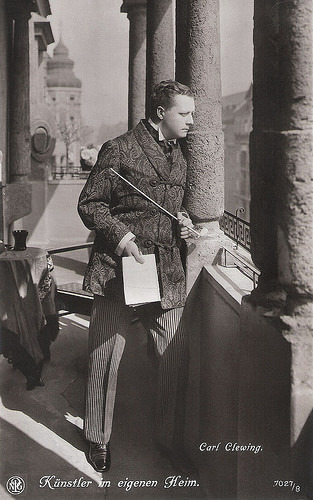
German postcard by NPG, no. 7027/8. Caption: "Künstler im eigenen Heim" (the artist at his own home).
Sources: Thomas Staedeli (Cyranos), Wikipedia (German), and .

German postcard by Verlag Hermann Leiser, Berlin-Wilm., no. 755. Photo: Becker & Maass, Berlin.

German postcard in the Film Sterne series by Rotophot, no. 147. Photo: Becker & Maass, Berlin.
Ernst Lubitsch classic
Theodor Rudolph Carl Clewing was born in 1884 in Schwerin, Germany. His father was the owner of an apothecary.
Clewing studied in Prague. From 1909 he was an actor in Berlin and he was appointed Royal Court actor in 1911.
In the same year, Clewing also made his debut as a film actor in Der fremde Vogel/The Strange Bird (Urban Gad, 1911) starring Hans Mierendorff and Asta Nielsen .
In the next years followed roles in productions like Ein Sommernachtstraum in unserer Zeit (Stellan Rye, 1913) based on motives of William Shakespeare’s A Midsummer Night's Dream, the fantasy Der Ring des schwedischen Reiters/The ring of the Swedish riders (Stellan Rye, 1913), and Der Flug in die Sonne/The flight into the sun (Stellan Rye, 1914).
At the outbreak of the First World War, he announced himself voluntarily, and during the war he was repeatedly distinguished and promoted to lieutenant.
After the war, he was again active in Berlin as an opera singer, but also as a film actor. Among his films were the crime drama Whitechapel (Ewald André Dupont 1920) with Hans Mierendorff and Grit Hagasa, and Ernst Lubitsch ’s classic Sumurun (1920), in which Ewing played the young Sheik.
His final film was Das Floß der Toten/The raft of the dead (Carl Boese, 1920) with Aud Egede Nissen .
In the autumn of 1922, he had an engagement as 'Heldentenor' at the Staatsoper Berlin. In 1924-1925 he performed at the Bayreuth Festival and sang Walter von Stolzing and the Parsifal.
In 1922 he became a guest lecturer and professor at the State Conservatory of the Hochschule für Staats- & Wirtschaftswissenschaften in Detmold. In December 1928 he was appointed extraordinary professor for singing, vocal training and practical phonetics at the University of Music in Vienna.

German postcard by Verlag Herm. Leiser, no. 6120. Photo: Atelier Rembrandt, Berlin-Charlottenburg. Publicity still for a stage production of Weh dem, der lügt! by Franz Grillparzer with Carl Clewing in the role of Leon, the kitchen help.

German postcard by Verlag Hermann Leiser, Berlin-Wilm., no. 4110. Photo: Becker & Maass. Publicity still for the stage play Hohe Politik by Julius Rosen.

German postcard by Verlag Herm. Leiser, Berlin-Wilm., no. 9634. Photo: Becker & Maass.
A member of the NSDAP, the SA, and the SS
At the beginning of 1931 Carl Clewing moved back to Germany and was appointed professor at the Staatliche Hochschule für Musik in Berlin, and at the same time he was a representative of the Cooperative of German Stage Artists in the School of the German Stage Society, as well as a member of the Berlin Opera and Opera, and moved to Berlin-Lichterfelde-Ost.
After Adolf Hitler's rise to power, Clewing was a member of the NSDAP, the SA, and the SS. However, he was expelled in 1934, because he had concealed his ‘non-Aryan slippage’ and his former affiliation to a Masonic lodge.
In 1935 he composed the Schlager and folk play Alle Tage ist kein Sonntag. It was made into the film Alle Tage ist kein Sonntag/Every Day Isn't Sunday(Walter Janssen, 1935) with Adele Sandrock and Wolfgang Liebeneiner .
In the second half of the 1930s, Clewing, who was also a passionate hunter and collector of hunting culture, was entrusted by Hermann Göring, who was the 'Reichsjägermeister', to issue the series of monuments of German hunting culture. The first volume appeared as early as 1937, as well as a folk edition of 100 huntsmen and a songbook of the Luftwaffe.
During this time he also developed a small form of the Fürst-Pless-Horn, which is also called 'Clewingsches Taschenjagdhorn'.
In May 1939 he returned as an opera singer. In the same year, he wrote a cantata on the birth of Edda Goering.
After the Second World War he lived in the sanatorium in Glotterbad near Freiburg im Breisgau and spent his retirement in the health resort Dr. Saller in Badenweiler. Carl Clewing passed away in Badenweiler, Baden-Württemberg, Germany in 1954.
In 1923, Clewing had married Elisabeth (Else) née Mulert, adopted Arnhold, widowed Kunheim. They divorced in 1940, and had a son, Carl Peter (1924-1943, fallen at Salerno).

German postcard by Verlag Hermann Leiser, Berlin-Wilm., no. 3931. Photo: Atelier Rembrandt, Charlottenburg. Publicity still for a stage production of Der grosse König (The Great King).

German postcard by NPG, no. 7027/8. Caption: "Künstler im eigenen Heim" (the artist at his own home).
Sources: Thomas Staedeli (Cyranos), Wikipedia (German), and .
Published on July 25, 2017 22:00
July 24, 2017
Claude Rich (1929-2017)
On Thursday 20 July 2017, French actor Claude Rich passed away. He played in at least fifty plays and around 80 films, among them the cult classic Les Tontons flingueurs/Crooks in Clover (1963) alongside Lino Ventura, and François Truffaut’s La mariée était en noir/The Bride Wore Black (1968). Over the course of his long career, he worked with some of the best known French film directors such as Jean Renoir, Julien Duvivier, Claude Chabrol, and Alain Resnais.
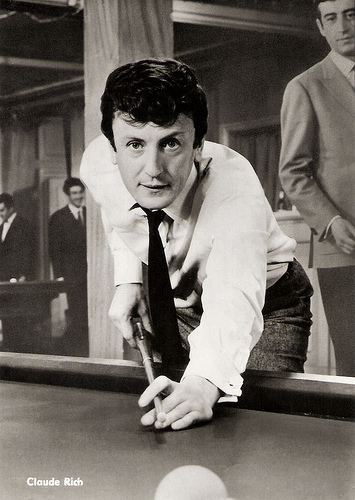
East-German postcard by VEB Progress Film-Vertrieb, Berlin, no. 154/71. Photo: publicity still for Un milliard dans un billard/Diamond Cue (Nicolas Gessner, 1965).
Neither Seen Nor Recognized
Claude Robert Rich was born in Strasbourg, eastern France, in 1929. He was the son of Roger Rich and Marguerite Labat. In 1935, after the death of his father, he moved with his mother and three brothers and sisters to Paris.
Later when he worked as a bank employee in order to bring money home to help his mother, he enrolled in evening classes drama by Charles Dullin at le Centre d'Art Dramatique de la rue Blanche. While working and studying, he decided to make a go of acting and entered a competition for a scholarship to the prestigious Conservatoire National Supérieur d'Art dramatique.
He won the scholarship and started studying acting full-time in 1953. At the Conservatoire, he met and befriended many who would also become well known actors, including Annie Girardot , Jean-Paul Belmondo , and Jean Rochefort .
Rich made his debut at the Renaissance Theater, and made his film debut in René Clair's Les Grandes Manœuvres/The Grand Maneuver (1955). He followed it with a part in the comedy Mitsou (Jacqueline Audry, 1956) starring Danièle Delorme , and based on the 1919 novella Mitsou by Colette.
In the comedy hit Ni vu, ni connu/Neither Seen Nor Recognized (Yves Robert, 1958), he appeared with Louis de Funès . Another hit at the box offices was the anthology film La française et l'amour/Love and the Frenchwoman (1960). In one of the segments he co-starred with Marie-José Nat .
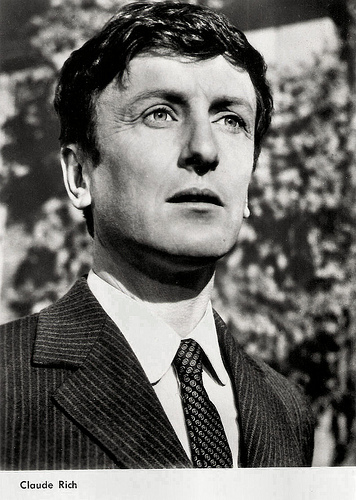
East-German postcard by VEB Progress Film-Vertrieb, Berlin, no. 2722. Photo: publicity still for Mona, l'étoile sans nom/Nameless Star (Henri Colpi, 1966).
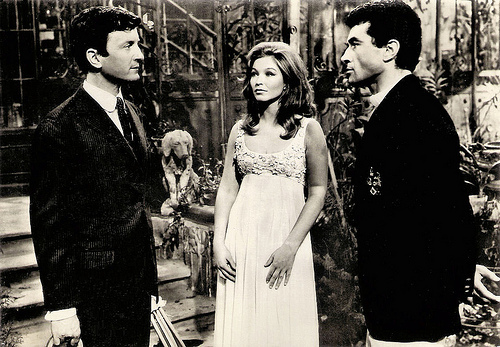
East-German postcard by VEB Progress Film-Vertrieb, Berlin, no. 2723, 1966. Photo: publicity still for Mona, l'étoile sans nom/Nameless Star (Henri Colpi, 1966) with Marina Vlady and Cristea Avram.
Cult Classic
For much of the 1960s, Claude Rich took on secondary roles in such films as La chambre ardente/The Burning Court (Julien Duvivier, 1962), in a segment directed by Claude Chabrol in the anthology Les Sept péchés capitaux/The seven deadly Sins (1962) and Le Caporal épinglé/The Elusive Corporal (Jean Renoir, 1962) starring Jean-Pierre Cassel .
He acted alongside Lino Ventura in the cult classic Les Tontons flingueurs/Crooks in Clover (Georges Lautner, 1963). He played both Gen. Leclerc and Lt. Pierre de la Fouchardière in Paris brûle-t-il?/Is Paris Burning? (René Clément, 1966). The following year, he played with Louis de Funès in the comedy of errors Oscar (Edouard Molinaro, 1967).
He landed his first major role in Alain Resnais’s Science-Fiction film, Je t’aime, je t’aime/I Love You, I Love You (1968). He interpreted a man who tried to commit suicide and is selected by a secret organisation in order to experiment a very dangerous and quite hopeless voyage, a journey in his own past. Resnais chose him for the role because of the special timbre of his voice.
It was followed by La mariée était en noir/The Bride Wore Black (François Truffaut, 1968). Rich is one of the five men who is responsible for the death of Jeanne Moreau 's fiancé. At a party being held in his high-rise apartment, the Bride pushes him off the balcony and he falls to his death.
Rich was also an impressive theatre performer. He was a five-time finalist for the Molière award, France’s national theatre award. He shined in the play Le Souper (The Supper) by Jean-Claude Brisville, where he played Talleyrand alongside actor Claude Brasseur, as Joseph Fouché. Both Rich and Brasseur would portray these characters once more for the film adaptation Le Souper/The Supper (Édouard Molinaro, 1992). In 1993, he received the Cesar for best actor with this performance.
Rich was nominated four times for best supporting actor, in La Fille d’Artagnan/Revenge of the Musketeers (Bertrand Tavernier, 1994), La Bûche/Season's Beatings (Danièle Thompson, 1999), Aide-toi le ciel t’aidera/With a Little Help from Myself (François Dupeyron, 2008) and Cherchez Hortense/Looking for Hortense (Pascal Bonitzer, 2012). Among his other awards were a Grammy Award in 1974, and a César d’Honneur in 2003.
Claude Rich died after a long illness in his home in Orgeval, France. He was 88. Since 1959, he was married to Catherine Rich born Renaudin and they had three children, Delphine, Natalie and Rémy Rich.
American trailer for La Bûche/Season's Beatings (1999). Source: Video Detective (YouTube).
Trailer Et si on vivait tous ensemble?/All Together (2011). Source: Movie Covfefe - Coverage (YouTube).
Sources: Montreal Gazette, RFI, Les Gens du Cinéma (French), Wikipedia (French and English), and .

East-German postcard by VEB Progress Film-Vertrieb, Berlin, no. 154/71. Photo: publicity still for Un milliard dans un billard/Diamond Cue (Nicolas Gessner, 1965).
Neither Seen Nor Recognized
Claude Robert Rich was born in Strasbourg, eastern France, in 1929. He was the son of Roger Rich and Marguerite Labat. In 1935, after the death of his father, he moved with his mother and three brothers and sisters to Paris.
Later when he worked as a bank employee in order to bring money home to help his mother, he enrolled in evening classes drama by Charles Dullin at le Centre d'Art Dramatique de la rue Blanche. While working and studying, he decided to make a go of acting and entered a competition for a scholarship to the prestigious Conservatoire National Supérieur d'Art dramatique.
He won the scholarship and started studying acting full-time in 1953. At the Conservatoire, he met and befriended many who would also become well known actors, including Annie Girardot , Jean-Paul Belmondo , and Jean Rochefort .
Rich made his debut at the Renaissance Theater, and made his film debut in René Clair's Les Grandes Manœuvres/The Grand Maneuver (1955). He followed it with a part in the comedy Mitsou (Jacqueline Audry, 1956) starring Danièle Delorme , and based on the 1919 novella Mitsou by Colette.
In the comedy hit Ni vu, ni connu/Neither Seen Nor Recognized (Yves Robert, 1958), he appeared with Louis de Funès . Another hit at the box offices was the anthology film La française et l'amour/Love and the Frenchwoman (1960). In one of the segments he co-starred with Marie-José Nat .

East-German postcard by VEB Progress Film-Vertrieb, Berlin, no. 2722. Photo: publicity still for Mona, l'étoile sans nom/Nameless Star (Henri Colpi, 1966).

East-German postcard by VEB Progress Film-Vertrieb, Berlin, no. 2723, 1966. Photo: publicity still for Mona, l'étoile sans nom/Nameless Star (Henri Colpi, 1966) with Marina Vlady and Cristea Avram.
Cult Classic
For much of the 1960s, Claude Rich took on secondary roles in such films as La chambre ardente/The Burning Court (Julien Duvivier, 1962), in a segment directed by Claude Chabrol in the anthology Les Sept péchés capitaux/The seven deadly Sins (1962) and Le Caporal épinglé/The Elusive Corporal (Jean Renoir, 1962) starring Jean-Pierre Cassel .
He acted alongside Lino Ventura in the cult classic Les Tontons flingueurs/Crooks in Clover (Georges Lautner, 1963). He played both Gen. Leclerc and Lt. Pierre de la Fouchardière in Paris brûle-t-il?/Is Paris Burning? (René Clément, 1966). The following year, he played with Louis de Funès in the comedy of errors Oscar (Edouard Molinaro, 1967).
He landed his first major role in Alain Resnais’s Science-Fiction film, Je t’aime, je t’aime/I Love You, I Love You (1968). He interpreted a man who tried to commit suicide and is selected by a secret organisation in order to experiment a very dangerous and quite hopeless voyage, a journey in his own past. Resnais chose him for the role because of the special timbre of his voice.
It was followed by La mariée était en noir/The Bride Wore Black (François Truffaut, 1968). Rich is one of the five men who is responsible for the death of Jeanne Moreau 's fiancé. At a party being held in his high-rise apartment, the Bride pushes him off the balcony and he falls to his death.
Rich was also an impressive theatre performer. He was a five-time finalist for the Molière award, France’s national theatre award. He shined in the play Le Souper (The Supper) by Jean-Claude Brisville, where he played Talleyrand alongside actor Claude Brasseur, as Joseph Fouché. Both Rich and Brasseur would portray these characters once more for the film adaptation Le Souper/The Supper (Édouard Molinaro, 1992). In 1993, he received the Cesar for best actor with this performance.
Rich was nominated four times for best supporting actor, in La Fille d’Artagnan/Revenge of the Musketeers (Bertrand Tavernier, 1994), La Bûche/Season's Beatings (Danièle Thompson, 1999), Aide-toi le ciel t’aidera/With a Little Help from Myself (François Dupeyron, 2008) and Cherchez Hortense/Looking for Hortense (Pascal Bonitzer, 2012). Among his other awards were a Grammy Award in 1974, and a César d’Honneur in 2003.
Claude Rich died after a long illness in his home in Orgeval, France. He was 88. Since 1959, he was married to Catherine Rich born Renaudin and they had three children, Delphine, Natalie and Rémy Rich.
American trailer for La Bûche/Season's Beatings (1999). Source: Video Detective (YouTube).
Trailer Et si on vivait tous ensemble?/All Together (2011). Source: Movie Covfefe - Coverage (YouTube).
Sources: Montreal Gazette, RFI, Les Gens du Cinéma (French), Wikipedia (French and English), and .
Published on July 24, 2017 22:00
July 23, 2017
Maria Cebotari
Celebrated Romanian soprano and actress Maria Cebotari (1910-1949) was one of Europe's greatest opera stars in the 1930s and 1940s. Especially her interpretations of the works of Wolfgang Amadeus Mozart and Richard Strauss belonged to her specialities. Cebotari also starred in several films related to opera.
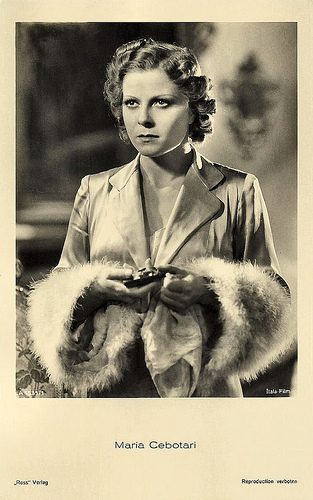
German postcard by Ross Verlag, no. A 1531/1, 1937-1938. Photo: Itala-Film. Publicity still for Mutterlied/Solo Per Te/Mother Song (Carmine Gallone, 1937).
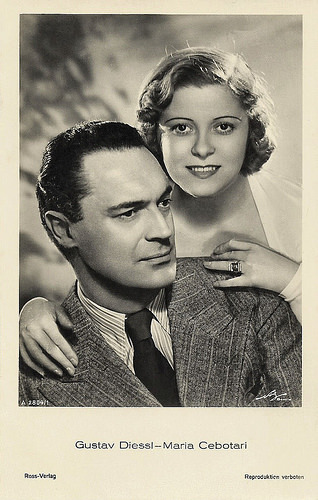
With husband Gustav Diessl. German postcard by Ross Verlag, no. A 2804/1, 1939-1940. Photo: Wog, Berlin.
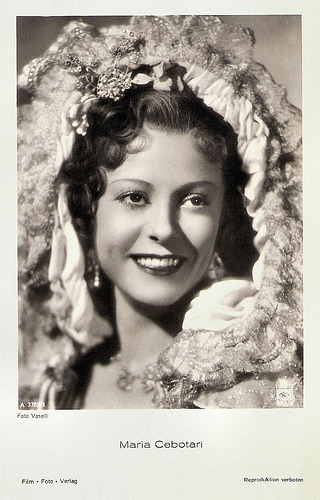
German postcard by Film-Foto-Verlag, no. A 3789/1, 1941-1944. Photo: Vaselli / A.C.I. / Europa Film. Photo: Maria Malibran (Guido Brignone, 1943).
Prima donna
Maria Cebotari was born Maria Cebotaru in Kishinev, Russian Empire (now Chişinău, Moldova) in 1910. She grew up speaking Romanian and Russian.
At the age of four, she began to sing in churches. Later she studied singing at the Chişinău Conservatory. In 1929 the Moscow Art Theatre Company visited her town and she was discovered and joined the company as an actress. In 1930 she married the company's leader, Count Alexander Virubov.
Moving to Berlin with the company, she studied singing with Oskar Daniel for three months and made her debut as an operatic singer as Mimi in Giacomo Puccini's opera La Bohème at Dresden Semperoper (Dresden Semper Opera House) in 1931.
Bruno Walter invited her to the Salzburg Festival, where she sang Euridice in Christoph Willibald Gluck's opera Orfeo ed Euridice. In 1935, she sang the part of Aminta in the world premiere of Richard Strauss' opera Die Schweigsame Frau (The Silent Woman) under Karl Böhm at Dresden Semper Opera House.
Strauss advised her to move to Berlin, and in 1936 she joined the Berlin State Opera, where she was a prima donna until 1946. She divorced Count Virubov in 1938, and married the Austrian actor Gustav Diessl , with whom she had two sons.
Beside her successful career at the opera houses, Cebotari appeared in several films which were often related to opera. Her first starring role was in Mädchen in Weiß/Girls in White (Victor Janson, 1936) opposite Iván Petrovich .
Among her other films are Mutterlied/Solo Per Te/Mother Song (Carmine Gallone, 1937) with Beniamino Gigli , Giuseppe Verdi/Verdi's Three Women (Carmine Gallone, 1938) featuring Fosco Giachetti , and Il sogno di Butterfly/The Dream of Madame Butterfly (Carmine Gallone, 1939). With her husband, she made the film Starke Herzen/Strong Hearts in the Storm (Herbert Maisch, 1937).
She also played in the film Odessa in fiamme/Odessa in flames (Carmine Gallone, 1942), based on a script by Nicolae Kiriţescu. The Romanian-Italian co-production tells about the drama of the refugees from Bessarabia (Republic Moldova), in World War II and does homage to the Romanian troops who freed Bessarabia from the Red Army which occupied it in 1940. The film includes contemporary newsreels showing refugee columns running away.
The film won the great prize at the Festival of Venice, in 1942, but after the invasion by Soviet troops in Bucharest in 1944, the film was banned, and many of the actors arrested. Nothing was heard of the film for more than 50 years, but in 2006 it was re-discovered in the Cinecittà archives in Rome, and Odessa in fiamme was shown for the first time in Romania in December 2006.
Maria Cebotari's final film was the Italian drama Maria Malibran/The Genius and the Nightingale (Guido Brignone, 1943) with Rossano Brazzi .
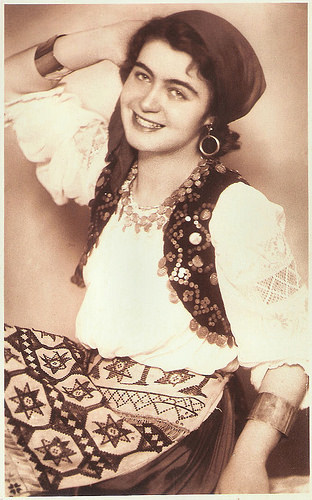
Austrian postcard by K ltd. Photo: Willi Pollak, Wien.
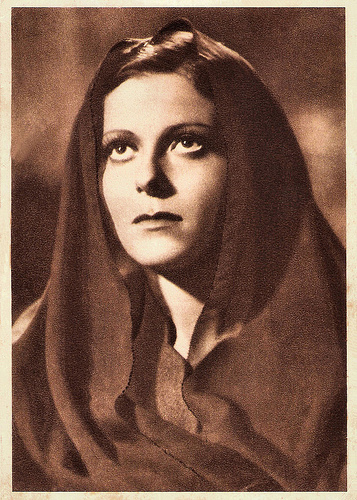
Italian postcard by Grafiche N. Moneto, Milano. Photo: Itala-Film / Generalcine. Publicity still for Mutterlied/Solo Per Te/Mother Song (Carmine Gallone, 1937).
An extremely versatile voice
In 1946, Maria Cebotari sang Susanna in Le Nozze di Figaro, Zerlina in Don Giovanni, and Sophie in Der Rosenkavalier for Dresden Semper Opera Company's performances at Covent Garden Royal Opera House of London.
From then on, she appeared at many great opera houses including Vienna State Opera and La Scala Opera House of Milan. Cebotari had an extremely versatile voice, and her repertoire covered coloratura, soubrette, lyric and dramatic roles; for example, she sang both Countess Almaviva and Susanna in Le nozze di Figaro, Violetta in La traviata and Salome in the same season.
Cebotari concentrated on four composers – Wolfgang Amadeus Mozart, Richard Strauss, Giuseppe Verdi and Giacomo Puccini. Strauss described her as "the best all-rounder on the European stage, and she is never late and she never cancels".
In 1946, she left Berlin and joined the Vienna State Opera House. She visited Covent Garden again in 1947 with Vienna State Opera Company and sang Salome, Donna Anna in Don Giovanni, and Countess Almaviva in Le nozze di Figaro. In 1947, she was Donna Anna to the Ottavio of Richard Tauber , making his final stage appearance, less than a week before his cancerous left lung was removed.
In 1948, her husband, Gustav Diessl , died of a heart attack. Cebotari suffered from severe pain during the performance of Le nozze di Figaro at La Scala Opera House in early 1949. At first, doctors did not take it seriously. However, on 31 March 1949, she fell down during the performance of Karl Millöcker's operetta Der Bettelstudent in Vienna.
During surgery, doctors found cancer in her liver and pancreas. Short before her dead. Herbert von Karajan engaged Maria Cebotari for the 1949 Salzburg Music Festival in Austria, in Mozart's The Marriage of Figaro.
On 9 June 1949, Maria Cebotari died from cancer in her villa in Vienna. She was only 40. Her funeral in Vienna was an imposing demonstration of love and honour, with thousands of people attending.
British pianist Sir Clifford Curzon adopted her two little sons. Beniamino Gigli remembered Cebotari as one of the greatest female voices he ever heard, and Herbert von Karajan later said she was the greatest Madame Butterfly he had ever conducted.
In 2005, director Victor Druc made the documentary Aria (2005) about Cebotari’s life. The documentary faced difficulties when it was screened in Moldova during the Communist administration which ended in 2009. The cause for the difficulties was a scene in which the soprano self-identifies as Romanian, contrary to the official policy of the Communist government that calls the ethnic majority Moldovan, rather than Romanian.

German postcard by Ross Verlag, no. A 3097/1, 1941-1944. Photo: Tita Binz, Berlin.
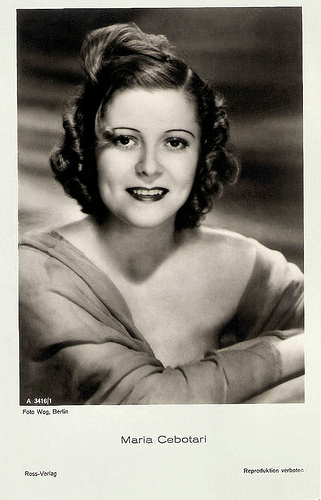
German postcard by Ross Verlag, no. A 3416/1, 1941-1944. Photo: Wog, Berlin.
Sources: Andrea Suhm-Binder (Cantabile-subito), Rudi Polt (Find A Grave), Wikipedia and .

German postcard by Ross Verlag, no. A 1531/1, 1937-1938. Photo: Itala-Film. Publicity still for Mutterlied/Solo Per Te/Mother Song (Carmine Gallone, 1937).

With husband Gustav Diessl. German postcard by Ross Verlag, no. A 2804/1, 1939-1940. Photo: Wog, Berlin.

German postcard by Film-Foto-Verlag, no. A 3789/1, 1941-1944. Photo: Vaselli / A.C.I. / Europa Film. Photo: Maria Malibran (Guido Brignone, 1943).
Prima donna
Maria Cebotari was born Maria Cebotaru in Kishinev, Russian Empire (now Chişinău, Moldova) in 1910. She grew up speaking Romanian and Russian.
At the age of four, she began to sing in churches. Later she studied singing at the Chişinău Conservatory. In 1929 the Moscow Art Theatre Company visited her town and she was discovered and joined the company as an actress. In 1930 she married the company's leader, Count Alexander Virubov.
Moving to Berlin with the company, she studied singing with Oskar Daniel for three months and made her debut as an operatic singer as Mimi in Giacomo Puccini's opera La Bohème at Dresden Semperoper (Dresden Semper Opera House) in 1931.
Bruno Walter invited her to the Salzburg Festival, where she sang Euridice in Christoph Willibald Gluck's opera Orfeo ed Euridice. In 1935, she sang the part of Aminta in the world premiere of Richard Strauss' opera Die Schweigsame Frau (The Silent Woman) under Karl Böhm at Dresden Semper Opera House.
Strauss advised her to move to Berlin, and in 1936 she joined the Berlin State Opera, where she was a prima donna until 1946. She divorced Count Virubov in 1938, and married the Austrian actor Gustav Diessl , with whom she had two sons.
Beside her successful career at the opera houses, Cebotari appeared in several films which were often related to opera. Her first starring role was in Mädchen in Weiß/Girls in White (Victor Janson, 1936) opposite Iván Petrovich .
Among her other films are Mutterlied/Solo Per Te/Mother Song (Carmine Gallone, 1937) with Beniamino Gigli , Giuseppe Verdi/Verdi's Three Women (Carmine Gallone, 1938) featuring Fosco Giachetti , and Il sogno di Butterfly/The Dream of Madame Butterfly (Carmine Gallone, 1939). With her husband, she made the film Starke Herzen/Strong Hearts in the Storm (Herbert Maisch, 1937).
She also played in the film Odessa in fiamme/Odessa in flames (Carmine Gallone, 1942), based on a script by Nicolae Kiriţescu. The Romanian-Italian co-production tells about the drama of the refugees from Bessarabia (Republic Moldova), in World War II and does homage to the Romanian troops who freed Bessarabia from the Red Army which occupied it in 1940. The film includes contemporary newsreels showing refugee columns running away.
The film won the great prize at the Festival of Venice, in 1942, but after the invasion by Soviet troops in Bucharest in 1944, the film was banned, and many of the actors arrested. Nothing was heard of the film for more than 50 years, but in 2006 it was re-discovered in the Cinecittà archives in Rome, and Odessa in fiamme was shown for the first time in Romania in December 2006.
Maria Cebotari's final film was the Italian drama Maria Malibran/The Genius and the Nightingale (Guido Brignone, 1943) with Rossano Brazzi .

Austrian postcard by K ltd. Photo: Willi Pollak, Wien.

Italian postcard by Grafiche N. Moneto, Milano. Photo: Itala-Film / Generalcine. Publicity still for Mutterlied/Solo Per Te/Mother Song (Carmine Gallone, 1937).
An extremely versatile voice
In 1946, Maria Cebotari sang Susanna in Le Nozze di Figaro, Zerlina in Don Giovanni, and Sophie in Der Rosenkavalier for Dresden Semper Opera Company's performances at Covent Garden Royal Opera House of London.
From then on, she appeared at many great opera houses including Vienna State Opera and La Scala Opera House of Milan. Cebotari had an extremely versatile voice, and her repertoire covered coloratura, soubrette, lyric and dramatic roles; for example, she sang both Countess Almaviva and Susanna in Le nozze di Figaro, Violetta in La traviata and Salome in the same season.
Cebotari concentrated on four composers – Wolfgang Amadeus Mozart, Richard Strauss, Giuseppe Verdi and Giacomo Puccini. Strauss described her as "the best all-rounder on the European stage, and she is never late and she never cancels".
In 1946, she left Berlin and joined the Vienna State Opera House. She visited Covent Garden again in 1947 with Vienna State Opera Company and sang Salome, Donna Anna in Don Giovanni, and Countess Almaviva in Le nozze di Figaro. In 1947, she was Donna Anna to the Ottavio of Richard Tauber , making his final stage appearance, less than a week before his cancerous left lung was removed.
In 1948, her husband, Gustav Diessl , died of a heart attack. Cebotari suffered from severe pain during the performance of Le nozze di Figaro at La Scala Opera House in early 1949. At first, doctors did not take it seriously. However, on 31 March 1949, she fell down during the performance of Karl Millöcker's operetta Der Bettelstudent in Vienna.
During surgery, doctors found cancer in her liver and pancreas. Short before her dead. Herbert von Karajan engaged Maria Cebotari for the 1949 Salzburg Music Festival in Austria, in Mozart's The Marriage of Figaro.
On 9 June 1949, Maria Cebotari died from cancer in her villa in Vienna. She was only 40. Her funeral in Vienna was an imposing demonstration of love and honour, with thousands of people attending.
British pianist Sir Clifford Curzon adopted her two little sons. Beniamino Gigli remembered Cebotari as one of the greatest female voices he ever heard, and Herbert von Karajan later said she was the greatest Madame Butterfly he had ever conducted.
In 2005, director Victor Druc made the documentary Aria (2005) about Cebotari’s life. The documentary faced difficulties when it was screened in Moldova during the Communist administration which ended in 2009. The cause for the difficulties was a scene in which the soprano self-identifies as Romanian, contrary to the official policy of the Communist government that calls the ethnic majority Moldovan, rather than Romanian.

German postcard by Ross Verlag, no. A 3097/1, 1941-1944. Photo: Tita Binz, Berlin.

German postcard by Ross Verlag, no. A 3416/1, 1941-1944. Photo: Wog, Berlin.
Sources: Andrea Suhm-Binder (Cantabile-subito), Rudi Polt (Find A Grave), Wikipedia and .
Published on July 23, 2017 22:00
July 22, 2017
Armand Bernard
Armand Bernard (1893-1968) was a French actor, composer and band leader. With his heavy diction and his air of dignity he brought a comical note to many French comedies.
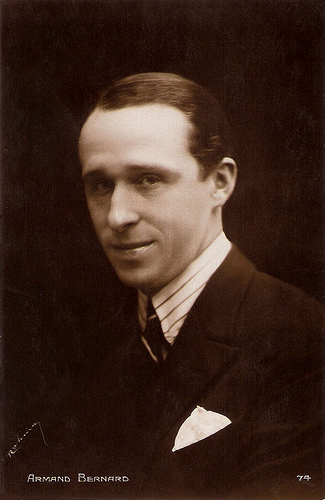
French postcard by Cinémagazine Edition, no. 74.
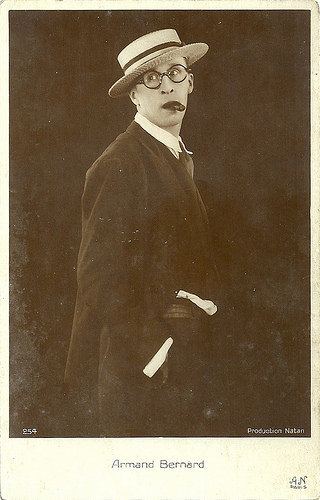
French postcard by A.N., Paris, no. 254. Photo: Production Natan.
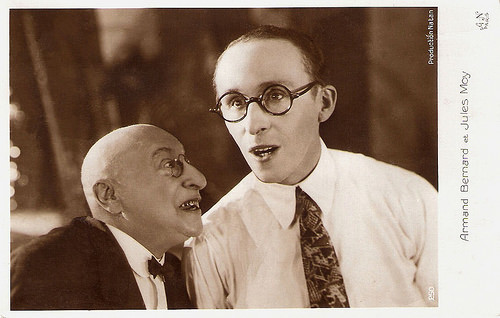
French postcard by A.N., Paris, no. 250. Photo: Production Natan. Publicity still for Rue de la paix (Henri Diamant-Berger, 1927) with Jules Moy.
The Mundane Snob
Armand Bernard was born in Bois-Colombes, France in 1893.
The young Bernard dreamt of a career as an actor in stage tragedies, but his serious voice and his constant dignified appearance chose otherwise for him.
In various comic films he played the mundane snob, the moron, the notary and even better the undertaker. His appearance often stole the show of other comedians as in the Fernandel comedies Les gueux au paradis/Hoboes in Paradise (René Le Henaff, 1946) and On demande un assassin/Assassin Wanted (Ernst Neubach, 1948).
Bernard was just as popular as the writer of film music for films such as Le million/The Million (René Clair, 1931) and Pension Mimosas/Pension Mimosa (Jacques Feyder, 1934) while he arranged the music for Sous les toits de Paris/Under the Roofs of Paris (René Clair, 1930). Bernard was also musical director for such films as Luis Bunuel’s L'âge d'or/The Golden Age (Luis Bunuel, 1930) and À nous la liberté (René Clair, 1931).
From 1914 on, Bernard had been highly active in the silent cinema. He was Planchet, valet of D’Artagnan in the super-production Les trois mousquetaires/The Three Musketeers (Henri Diamant-Berger, 1921) and the sequel Vingts ans après/Five Years later (Henri Diamant-Berger, 1922).
Bernard appeared in several films by Raymond Bernard, such as Le Petit Café/The Little Cafe (Raymond Bernard, 1919) with Max Linder , Le Miracle des loups/The Miracle of the Wolves (Raymond Bernard, 1924) with Charles Dullin , and Le Joueur des éches/The Chess Player (Raymond Bernard, 1927) with Pierre Blanchar .
He also acted in films by André Hugon such as Le Diamant noir/The Black Diamond (André Hugon, 1922) and Les Deux Pigeons/The two Pigeons (André Hugon, 1922), and he played the part of Jean-Jean in Abel Gance ’s classic Napoléon (Abel Gance, 1927).
After Diamant-Berger’s musketeer films, Bernard came back to him in the late 1920s for Éducation de prince/Education of a Prince (Henri Diamant-Berger, 1927) with Pierre Batcheff and Rue de la paix (Henri Diamant-Berger, 1927) with Léon Mathot .
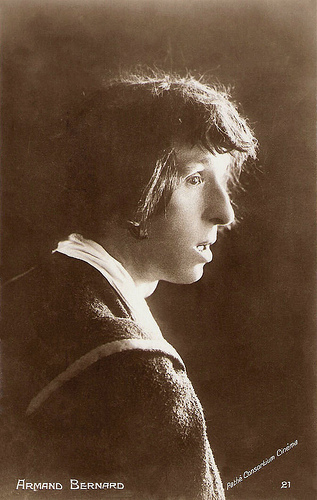
French postcard by Cinémagazine Edition, no. 21. Photo: Pathé Consortium Cinéma.
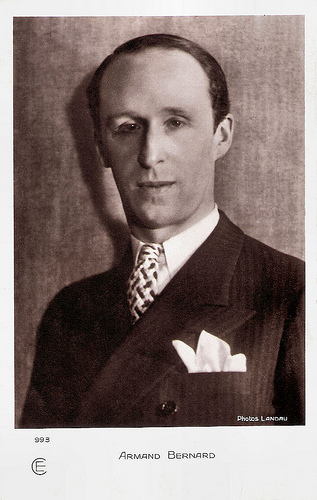
French postcard by Editions Cinémagazine, no. 993. Photo: Landau.
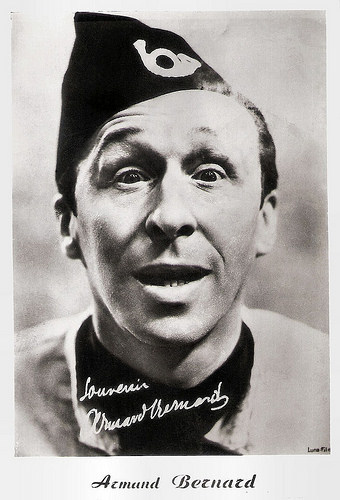
French postcard by Combier Imp., Macon. Photo: Luna-Film. Publicity still for La margoton du bataillon/The Mascot of the Batallion (Jacques Darmont, 1933).
La Tirelire
Memorable early sound films with Armand Bernard are Fra Diavolo (Mario Bonnard, 1930) and Paris la nuit/Paris at Night (Henri Diamant-Berger, 1930).
Bernard also often played in the French version of Franco-German multilinguals of the 1930s: Tumultes/Tumults (Robert Siodmak, 1931) with Charles Boyer , Dactylo (Wilhelm Thiele, 1931), Le congress s’amuse/The Congress Dances (Erik Charrell, 1931) with Lilian Harvey and Henri Garat , Quick (Robert Siodmak, 1931) with Jules Berry and Lilian Harvey , Caprice de princesse (Henri-Georges Clouzot, Karl Hartl, 1933) starring Marie Bell , and Les dieux s’amusent/The gods have fun (Reinhold Schunzel, Albert Valentin, 1935) staring Henri Garat .
Dactylo (Wilhelm Thiele, 1931), starring Marie Glory , was the French version of Thiele’s Die Privatsekretärin/The Private Secretary (Wilhelm Thiele, 1931), starring Renate Müller . An Italian version, La segretaria privata (Goffredo Alessandrini, 1931), starred Elsa Merlini .
All were successes and Dactylo had an equally popular sequel in France, Dactylo se marie/Dactylo Marries (Joe May, René Pujol, 1934), again starring Glory with Bernard as her sidekick.
Bernard tried his luck with singing in Dactylo, even if his comic forte was more visual than oral, so he sang on a record two songs for the film - La tirelire (Boyer-Abraham) and Je vois la vie en rose (idem), French versions of Ich hab’ ne alte Tante and Ich bin ja heut’ so glücklich.
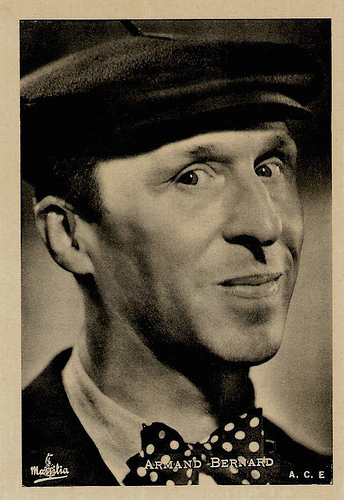
French card. Photo: Massilia/A.C.E.

French postcard by A.N., Paris, no. 812. Photo: GFFA.
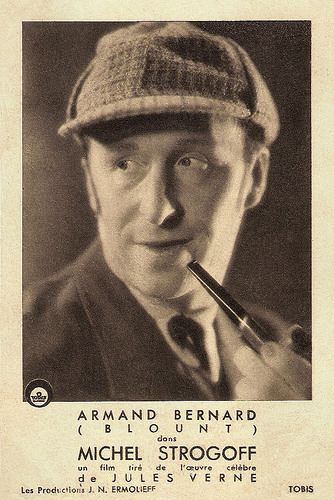
French postcard by Tobis. Photo: Les productions J.N. Ermolieff. Publicity still for Michel Strogoff (Jacques de Baroncelli, Richard Eichberg, 1936).
Comedies Of Course
Armand Bernard also played in the French, English and Austrian version of Les aventures du roi Pausole/The Merry Monarch (Alexis Granowsky, 1933), which had Emil Jannings in the English and Austrian version.
After new films with Diamant-Berger, Bernard also started to play in films by his younger brother Maurice Diamant-Berger (alias André Gillois) such as L’Enfant du miracle/The Miracle Child (D.B. Maurice, 1932).
From the mid-1930s on, Bernard played in several films by Christian-Jaque, such as Compartiment de dames seules/Compartment for ladies only (Christian-Jaque, 1936), L’école des journalistes/The school for journalists (Christian-Jaque, 1936), the murder mystery Les Disparus de St. Agil/Boys' School (Christian-Jaque, 1937) and the Fernandel comedy Raphaël le Tatoué/Raphaël the tattooed (Christian-Jaque, 1938).
Other directors connected to Bernard in the 1930s were Pierre Caron and René Pujol. During the war Bernard did not act in films, retaking his film career in 1945 with – of course – comedies like Bichon (René Jayet, 1948) and L’impeccable Henri/Impeccable Henri (Charles-Félix Tavano, 1948), in which he had the lead.
Until the late 1950s Bernard had a highly active film career, mostly in comedy, with titles like C’est la faute d’Adam/In Six Easy Lessons (Jacqueline Audry, 1948) with Dany Robin .
His last film role was in La bande à Bobo/Bobo's Band (Tony Saytor, 1963) while he also acted in three French TV series in the early 1960s, such as Loin de Rueil (Claude Barma, 1961), after Raymond Queneau’s novel.
Armand Bernard died in Paris in 1968. All in all he had worked on some 100 films.
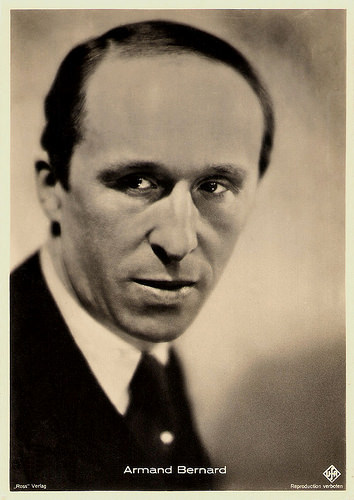
German postcard by Ross Verlag. Photo: Ufa.

French postcard by A.N., Paris, no. 983. Photo: Paramount.
Armand Bernard sings La Tirelire. Source: Leotaurus 1975 (YouTube).
Sources: Du temps des cerises aux feuilles mortes (French), Wikipedia (English and French), and .

French postcard by Cinémagazine Edition, no. 74.

French postcard by A.N., Paris, no. 254. Photo: Production Natan.

French postcard by A.N., Paris, no. 250. Photo: Production Natan. Publicity still for Rue de la paix (Henri Diamant-Berger, 1927) with Jules Moy.
The Mundane Snob
Armand Bernard was born in Bois-Colombes, France in 1893.
The young Bernard dreamt of a career as an actor in stage tragedies, but his serious voice and his constant dignified appearance chose otherwise for him.
In various comic films he played the mundane snob, the moron, the notary and even better the undertaker. His appearance often stole the show of other comedians as in the Fernandel comedies Les gueux au paradis/Hoboes in Paradise (René Le Henaff, 1946) and On demande un assassin/Assassin Wanted (Ernst Neubach, 1948).
Bernard was just as popular as the writer of film music for films such as Le million/The Million (René Clair, 1931) and Pension Mimosas/Pension Mimosa (Jacques Feyder, 1934) while he arranged the music for Sous les toits de Paris/Under the Roofs of Paris (René Clair, 1930). Bernard was also musical director for such films as Luis Bunuel’s L'âge d'or/The Golden Age (Luis Bunuel, 1930) and À nous la liberté (René Clair, 1931).
From 1914 on, Bernard had been highly active in the silent cinema. He was Planchet, valet of D’Artagnan in the super-production Les trois mousquetaires/The Three Musketeers (Henri Diamant-Berger, 1921) and the sequel Vingts ans après/Five Years later (Henri Diamant-Berger, 1922).
Bernard appeared in several films by Raymond Bernard, such as Le Petit Café/The Little Cafe (Raymond Bernard, 1919) with Max Linder , Le Miracle des loups/The Miracle of the Wolves (Raymond Bernard, 1924) with Charles Dullin , and Le Joueur des éches/The Chess Player (Raymond Bernard, 1927) with Pierre Blanchar .
He also acted in films by André Hugon such as Le Diamant noir/The Black Diamond (André Hugon, 1922) and Les Deux Pigeons/The two Pigeons (André Hugon, 1922), and he played the part of Jean-Jean in Abel Gance ’s classic Napoléon (Abel Gance, 1927).
After Diamant-Berger’s musketeer films, Bernard came back to him in the late 1920s for Éducation de prince/Education of a Prince (Henri Diamant-Berger, 1927) with Pierre Batcheff and Rue de la paix (Henri Diamant-Berger, 1927) with Léon Mathot .

French postcard by Cinémagazine Edition, no. 21. Photo: Pathé Consortium Cinéma.

French postcard by Editions Cinémagazine, no. 993. Photo: Landau.

French postcard by Combier Imp., Macon. Photo: Luna-Film. Publicity still for La margoton du bataillon/The Mascot of the Batallion (Jacques Darmont, 1933).
La Tirelire
Memorable early sound films with Armand Bernard are Fra Diavolo (Mario Bonnard, 1930) and Paris la nuit/Paris at Night (Henri Diamant-Berger, 1930).
Bernard also often played in the French version of Franco-German multilinguals of the 1930s: Tumultes/Tumults (Robert Siodmak, 1931) with Charles Boyer , Dactylo (Wilhelm Thiele, 1931), Le congress s’amuse/The Congress Dances (Erik Charrell, 1931) with Lilian Harvey and Henri Garat , Quick (Robert Siodmak, 1931) with Jules Berry and Lilian Harvey , Caprice de princesse (Henri-Georges Clouzot, Karl Hartl, 1933) starring Marie Bell , and Les dieux s’amusent/The gods have fun (Reinhold Schunzel, Albert Valentin, 1935) staring Henri Garat .
Dactylo (Wilhelm Thiele, 1931), starring Marie Glory , was the French version of Thiele’s Die Privatsekretärin/The Private Secretary (Wilhelm Thiele, 1931), starring Renate Müller . An Italian version, La segretaria privata (Goffredo Alessandrini, 1931), starred Elsa Merlini .
All were successes and Dactylo had an equally popular sequel in France, Dactylo se marie/Dactylo Marries (Joe May, René Pujol, 1934), again starring Glory with Bernard as her sidekick.
Bernard tried his luck with singing in Dactylo, even if his comic forte was more visual than oral, so he sang on a record two songs for the film - La tirelire (Boyer-Abraham) and Je vois la vie en rose (idem), French versions of Ich hab’ ne alte Tante and Ich bin ja heut’ so glücklich.

French card. Photo: Massilia/A.C.E.

French postcard by A.N., Paris, no. 812. Photo: GFFA.

French postcard by Tobis. Photo: Les productions J.N. Ermolieff. Publicity still for Michel Strogoff (Jacques de Baroncelli, Richard Eichberg, 1936).
Comedies Of Course
Armand Bernard also played in the French, English and Austrian version of Les aventures du roi Pausole/The Merry Monarch (Alexis Granowsky, 1933), which had Emil Jannings in the English and Austrian version.
After new films with Diamant-Berger, Bernard also started to play in films by his younger brother Maurice Diamant-Berger (alias André Gillois) such as L’Enfant du miracle/The Miracle Child (D.B. Maurice, 1932).
From the mid-1930s on, Bernard played in several films by Christian-Jaque, such as Compartiment de dames seules/Compartment for ladies only (Christian-Jaque, 1936), L’école des journalistes/The school for journalists (Christian-Jaque, 1936), the murder mystery Les Disparus de St. Agil/Boys' School (Christian-Jaque, 1937) and the Fernandel comedy Raphaël le Tatoué/Raphaël the tattooed (Christian-Jaque, 1938).
Other directors connected to Bernard in the 1930s were Pierre Caron and René Pujol. During the war Bernard did not act in films, retaking his film career in 1945 with – of course – comedies like Bichon (René Jayet, 1948) and L’impeccable Henri/Impeccable Henri (Charles-Félix Tavano, 1948), in which he had the lead.
Until the late 1950s Bernard had a highly active film career, mostly in comedy, with titles like C’est la faute d’Adam/In Six Easy Lessons (Jacqueline Audry, 1948) with Dany Robin .
His last film role was in La bande à Bobo/Bobo's Band (Tony Saytor, 1963) while he also acted in three French TV series in the early 1960s, such as Loin de Rueil (Claude Barma, 1961), after Raymond Queneau’s novel.
Armand Bernard died in Paris in 1968. All in all he had worked on some 100 films.

German postcard by Ross Verlag. Photo: Ufa.

French postcard by A.N., Paris, no. 983. Photo: Paramount.
Armand Bernard sings La Tirelire. Source: Leotaurus 1975 (YouTube).
Sources: Du temps des cerises aux feuilles mortes (French), Wikipedia (English and French), and .
Published on July 22, 2017 22:00
July 21, 2017
Twelve 1950s postcards from Italy
When we were in Bologna for Il Cinema Ritrovato, we found some sunny and glamorous Italian postcards of the 1950s at the Mostra of the festival. Today we like to share some of these new acquisitions with you. Next week, 12 postcards we recently found in Brighton, U.K.
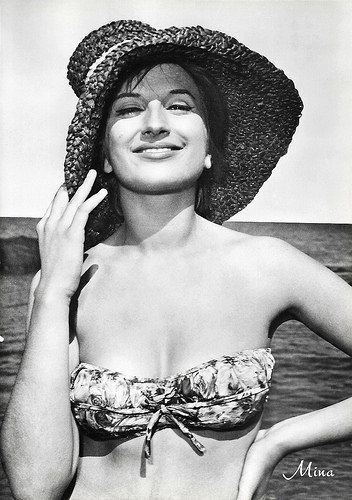
Mina . Italian postcard by Rotalfoto, Milano, no. 959.
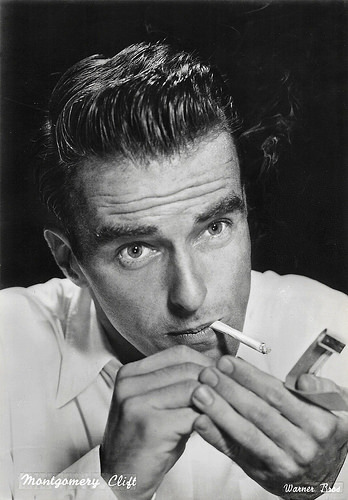
Montgomery Clift. Italian postcard by Bromofoto, Milano, no. 931. Photo: Warner Bros.
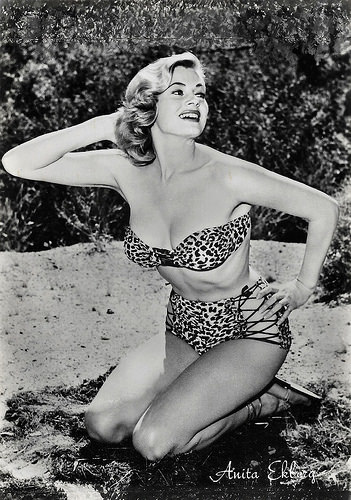
Anita Ekberg . Italian postcard by Rotalfoto, Milano, no. 666.

Jeffrey Hunter. Italian postcard by Bromostampa, Milano, no. 264.
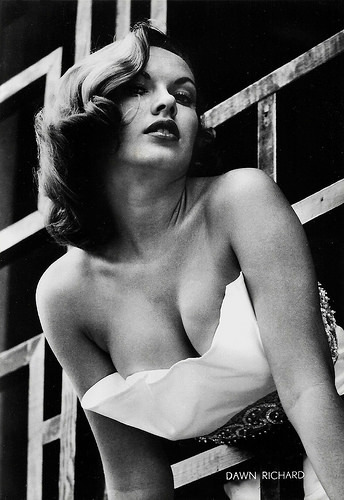
Dawn Richard. Italian postcard, no. 431.
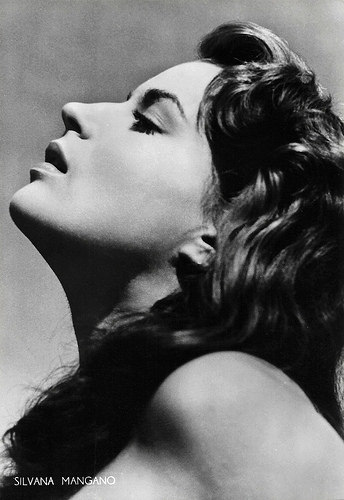
Silvana Mangano . Italian postcard by Bromostampa, Milano, no. 354.
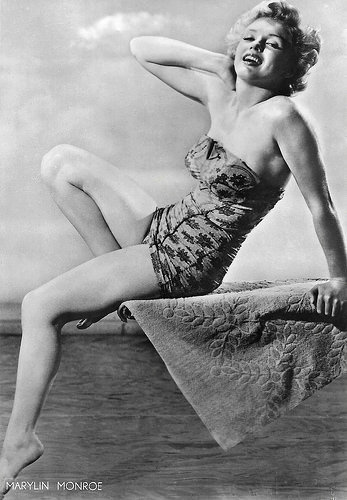
Marilyn Monroe . Italian postcard by Bromostampa, no. 371.
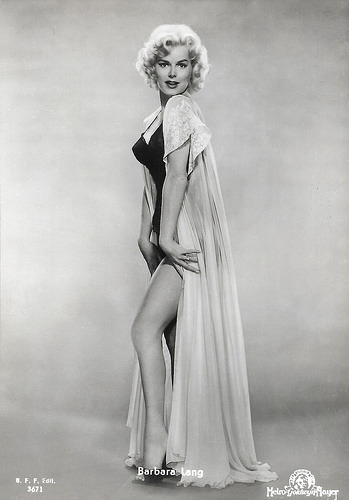
Barbara Lang. Italian postcard by Casa Editr. Ballerini & Fratini, Firenze, no. 3671. Photo: MGM. Publicity still for House of Numbers (Russell Rouse, 1957).
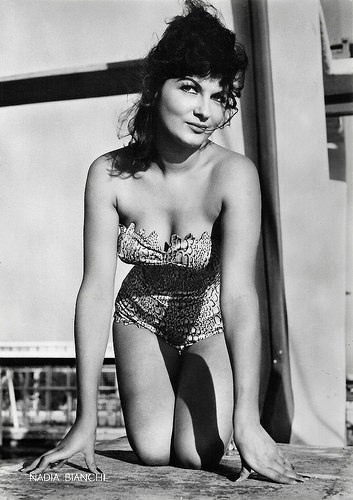
Nadia Bianchi . Italian postcard, no. 471.
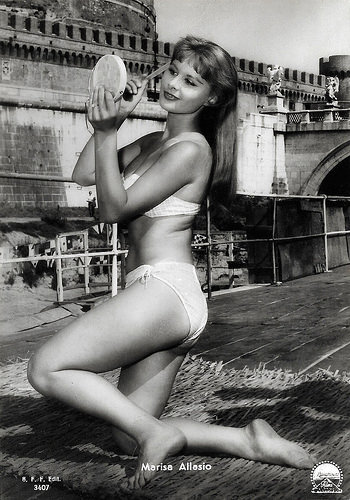
Marisa Allasio . Italian postcard by Casa Editr. Ballerini & Fratini, Firenze, no. 3407. Photo: Paramount / Titanus. Publicity still for Poveri ma belli/Poor but beautiful (Dino Risi, 1957).
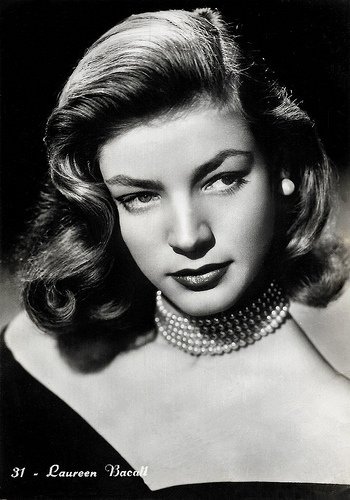
Lauren Bacall. Italian postcard by Turismofoto, no. 31.
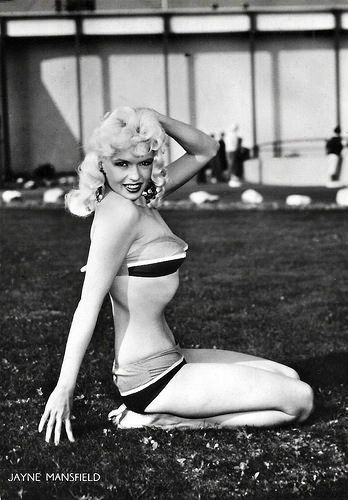
Jayne Mansfield . Italian postcard, no. 584.

Mina . Italian postcard by Rotalfoto, Milano, no. 959.

Montgomery Clift. Italian postcard by Bromofoto, Milano, no. 931. Photo: Warner Bros.

Anita Ekberg . Italian postcard by Rotalfoto, Milano, no. 666.

Jeffrey Hunter. Italian postcard by Bromostampa, Milano, no. 264.

Dawn Richard. Italian postcard, no. 431.

Silvana Mangano . Italian postcard by Bromostampa, Milano, no. 354.

Marilyn Monroe . Italian postcard by Bromostampa, no. 371.

Barbara Lang. Italian postcard by Casa Editr. Ballerini & Fratini, Firenze, no. 3671. Photo: MGM. Publicity still for House of Numbers (Russell Rouse, 1957).

Nadia Bianchi . Italian postcard, no. 471.

Marisa Allasio . Italian postcard by Casa Editr. Ballerini & Fratini, Firenze, no. 3407. Photo: Paramount / Titanus. Publicity still for Poveri ma belli/Poor but beautiful (Dino Risi, 1957).

Lauren Bacall. Italian postcard by Turismofoto, no. 31.

Jayne Mansfield . Italian postcard, no. 584.
Published on July 21, 2017 22:00
July 20, 2017
Alibert
French singer, actor and librettist Henri Allibert (1889-1951), known as Alibert, was the Marseille singer par excellence. During the 1930s and 1940s, he starred in his own very popular operettas both on stage and on the screen.
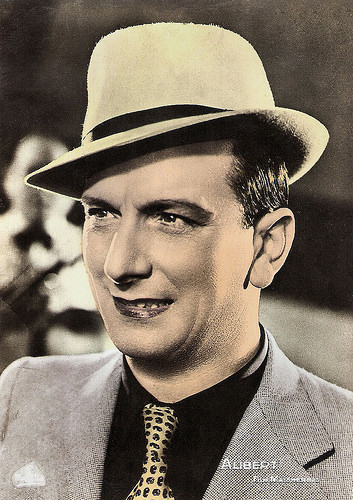
French card by Massilia. Photo: Film Malsherbes. Publicity still for Titin des Martigues (René Pujol, 1938).
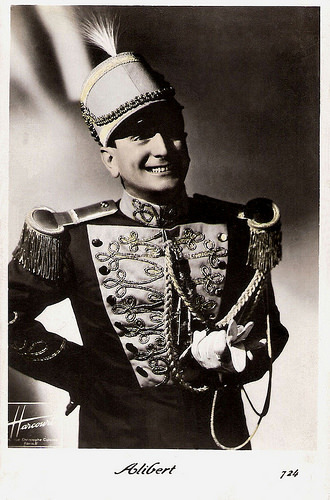
French postcard, no. 724. Photo: Studio Harcourt, Paris.
The rage of Marseille
Henri Allibert (with a double l) was born in 1889 in Carpentras in the south of France. When he was 15 his parents divorced and his mother and the children settled in Avignon.
He began to sing in the cafes where he worked as a waiter. In 1907, he made his debut as a singer at the Palace and in the cafes-concerts of Avignon, and in 1908 he moved to Paris where he appeared at the Bobino music hall.
As Alibert (with one l) he created a 'tour de chant', imitating the singers Polin and Mayol. He married pianist Elisa Rosalie Espanet in Marseille in 1913. She was the daughter of composer Vincent Scotto.
In 1914, Alibert was recruited for the army and in 1917, he returned with a decoration. After the First World War, he enjoyed the post-war euphoria and his revues became popular. He recorded the song Jazz band partout (Jazz band everywhere).
His career accelerated in 1928, when his father-in-law, Vincent Scotto gave him the song Mon Paris (My Paris), which showed his genuine talent and undeniable charm. In 1929, Marcel Pagnol wrote his play Marius, situated in Marseille and the harbour city was suddenly all the rage.
With two other men from Marseilles, his father-in-law Vincent Scotto and arranger-conductor René Sarvil, Alibert wrote and assembled the Revue Marseillaise to enjoy the fashion. This revue remained seven months prolonged in the theatre and was an unprecedented success. It meant Alibert’s definitive breakthrough, at the age of 40.
Then, Alibert starred in the Marseille-set operetta Elle est à nous (She is ours, 1929) created by Scotto, Sarvil and Alibert. With his clear voice and his light accent, he received the title of 'Marseille singer par excellence'. In the next years followed such operettas as Au pays du soleil (In the land of the sun, 1932), Arènes joyeuses (Happy Arenas) and Trois de la Marine (Three of the Navy, 1935).
In 1950 he had made his film debut in the early sound film Cendrillon de Paris/Cinderella of Paris (Jean Hémard, 1930), featuring Colette Darfeuil . His operetta Au pays de soleil was also made into a film, Au pays du soleil/In the land of the sun (Robert Péguy, 1934) in which he also starred opposite Lisette Lanvin and Pola Illéry . It was again a success.
From then on he made two operettas or films a year. His stage operettas include Un de la Canebière (One of the Canebieres, 1936), Les Gangsters du château d'If (1937), and Le Roi des galéjeurs (The king of the galleys, 1938).
His films were Trois de la marine/Three of the Navy (Charles Barrois, 1934) with Armand Bernard and Betty Stockfeld, Arènes joyeuses/Happy Arenas (Karl Anton, 1935) with Lucien Baroux , Titin des Martigues (René Pujol, 1937) with Paulette Dubost , Un de la Canebière/One from the Canebière (René Pujol, 1937) with Rellys , La Vie des artistes/Artist Life (Bernard Roland, 1938), and Les Gangsters du château d'If/The Gangster of If Castle (René Pujol, 1939).
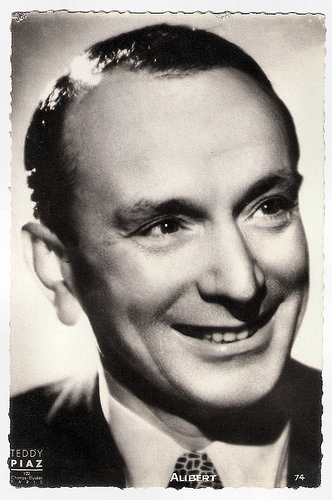
French postcard by Editions O.P., Paris, no. 74. Photo: Teddy Piaz, Paris.
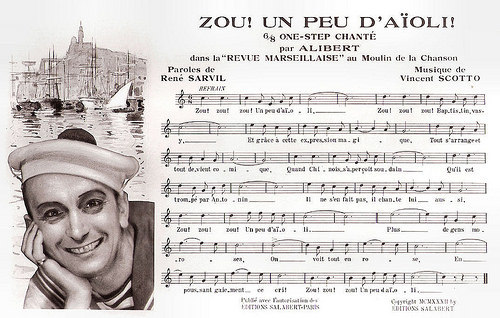
French card by P.C., Paris, no. 38. Henri Alibert sang the song Zou! Un peu dáïoli! (1932) by René Sarvil and Vincent Scotto in the Revue Marseillaise at the Moulin de la Chanson.
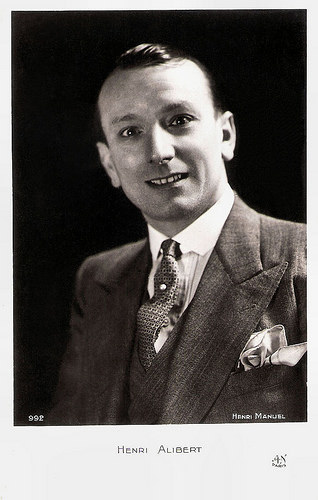
French postcard by A.N., Paris, no. 992. Photo: Henri Manuel.
Old School
Henri Allibert’s creational pace was barely slowed down during the Second World War. He created the operettas Ma Belle Marseillaise (1940), Port du Soleil (1941) and Les Gauchos de Marseille (1943), but made only one film, Le Roi des galéjeurs/The king of the galleys (Fernand Rivers, 1940) with Raymond Aimos and Claude May.
In 1946 Alibert starred in two more films, Au pays des cigales/In the land of the cicadas (Maurice Cam, 1946) with Nicolas Amato, and L'Affaire du Grand Hôtel/The Grand Hotel Affair (André Hugon, 1946) with Édouard Delmont.
The post-war period challenged the old school to which he belonged. He decided to devote himself entirely to his talents as a writer, lyricist and composer, and even became director of the Théâtre des Deux Ânes.
On stage he played the role of Marius in Marcel Pagnol's play Caesar. In 1951, his operetta Au pays du soleil was again made into film Au pays du soleil/In the land of the sun (Maurice de Canonge, 1951) with Tino Rossi in the leading role.
In 1949, Alibert was the victim of a serious car accident from which he never really recovered.
Henri Allibert died 1951 in Marseille at the age of 61 years. He was buried in Marseille, in the cemetery of Saint-Pierre. His wife was Antoinette Scotto.
After his death, several film versions of Alibert’s operettas were made including Trois de la Canebière (Maurice de Canonge, 1956) with Marcel Merkes, and Arènes joyeuses (Maurice de Canonge, 1958), starring Fernand Raynoud and Danielle Godet .
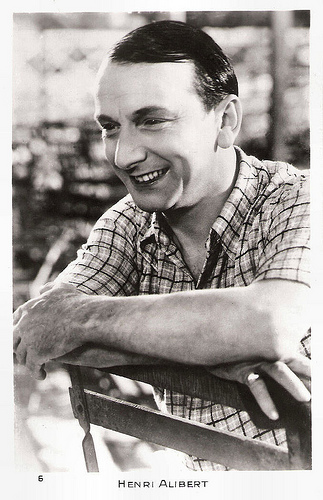
French postcard, no. 6.
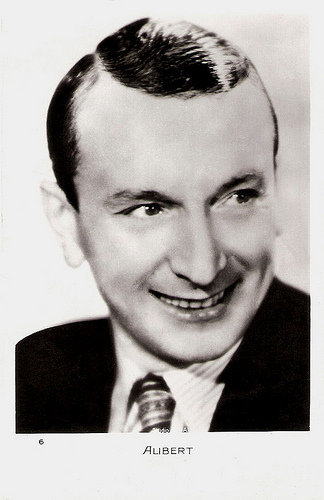
French postcard by Edition Chantal, Paris, no. 6. Photo: Studio Arnal.
Sources: Gerard Frappé (CinéArtistes - French), La Comédie musicale en France (French), Du temps des cerises aux feuilles mortes (French), Le Hall de la Chanson (French), Wikipedia (French) and .

French card by Massilia. Photo: Film Malsherbes. Publicity still for Titin des Martigues (René Pujol, 1938).

French postcard, no. 724. Photo: Studio Harcourt, Paris.
The rage of Marseille
Henri Allibert (with a double l) was born in 1889 in Carpentras in the south of France. When he was 15 his parents divorced and his mother and the children settled in Avignon.
He began to sing in the cafes where he worked as a waiter. In 1907, he made his debut as a singer at the Palace and in the cafes-concerts of Avignon, and in 1908 he moved to Paris where he appeared at the Bobino music hall.
As Alibert (with one l) he created a 'tour de chant', imitating the singers Polin and Mayol. He married pianist Elisa Rosalie Espanet in Marseille in 1913. She was the daughter of composer Vincent Scotto.
In 1914, Alibert was recruited for the army and in 1917, he returned with a decoration. After the First World War, he enjoyed the post-war euphoria and his revues became popular. He recorded the song Jazz band partout (Jazz band everywhere).
His career accelerated in 1928, when his father-in-law, Vincent Scotto gave him the song Mon Paris (My Paris), which showed his genuine talent and undeniable charm. In 1929, Marcel Pagnol wrote his play Marius, situated in Marseille and the harbour city was suddenly all the rage.
With two other men from Marseilles, his father-in-law Vincent Scotto and arranger-conductor René Sarvil, Alibert wrote and assembled the Revue Marseillaise to enjoy the fashion. This revue remained seven months prolonged in the theatre and was an unprecedented success. It meant Alibert’s definitive breakthrough, at the age of 40.
Then, Alibert starred in the Marseille-set operetta Elle est à nous (She is ours, 1929) created by Scotto, Sarvil and Alibert. With his clear voice and his light accent, he received the title of 'Marseille singer par excellence'. In the next years followed such operettas as Au pays du soleil (In the land of the sun, 1932), Arènes joyeuses (Happy Arenas) and Trois de la Marine (Three of the Navy, 1935).
In 1950 he had made his film debut in the early sound film Cendrillon de Paris/Cinderella of Paris (Jean Hémard, 1930), featuring Colette Darfeuil . His operetta Au pays de soleil was also made into a film, Au pays du soleil/In the land of the sun (Robert Péguy, 1934) in which he also starred opposite Lisette Lanvin and Pola Illéry . It was again a success.
From then on he made two operettas or films a year. His stage operettas include Un de la Canebière (One of the Canebieres, 1936), Les Gangsters du château d'If (1937), and Le Roi des galéjeurs (The king of the galleys, 1938).
His films were Trois de la marine/Three of the Navy (Charles Barrois, 1934) with Armand Bernard and Betty Stockfeld, Arènes joyeuses/Happy Arenas (Karl Anton, 1935) with Lucien Baroux , Titin des Martigues (René Pujol, 1937) with Paulette Dubost , Un de la Canebière/One from the Canebière (René Pujol, 1937) with Rellys , La Vie des artistes/Artist Life (Bernard Roland, 1938), and Les Gangsters du château d'If/The Gangster of If Castle (René Pujol, 1939).

French postcard by Editions O.P., Paris, no. 74. Photo: Teddy Piaz, Paris.

French card by P.C., Paris, no. 38. Henri Alibert sang the song Zou! Un peu dáïoli! (1932) by René Sarvil and Vincent Scotto in the Revue Marseillaise at the Moulin de la Chanson.

French postcard by A.N., Paris, no. 992. Photo: Henri Manuel.
Old School
Henri Allibert’s creational pace was barely slowed down during the Second World War. He created the operettas Ma Belle Marseillaise (1940), Port du Soleil (1941) and Les Gauchos de Marseille (1943), but made only one film, Le Roi des galéjeurs/The king of the galleys (Fernand Rivers, 1940) with Raymond Aimos and Claude May.
In 1946 Alibert starred in two more films, Au pays des cigales/In the land of the cicadas (Maurice Cam, 1946) with Nicolas Amato, and L'Affaire du Grand Hôtel/The Grand Hotel Affair (André Hugon, 1946) with Édouard Delmont.
The post-war period challenged the old school to which he belonged. He decided to devote himself entirely to his talents as a writer, lyricist and composer, and even became director of the Théâtre des Deux Ânes.
On stage he played the role of Marius in Marcel Pagnol's play Caesar. In 1951, his operetta Au pays du soleil was again made into film Au pays du soleil/In the land of the sun (Maurice de Canonge, 1951) with Tino Rossi in the leading role.
In 1949, Alibert was the victim of a serious car accident from which he never really recovered.
Henri Allibert died 1951 in Marseille at the age of 61 years. He was buried in Marseille, in the cemetery of Saint-Pierre. His wife was Antoinette Scotto.
After his death, several film versions of Alibert’s operettas were made including Trois de la Canebière (Maurice de Canonge, 1956) with Marcel Merkes, and Arènes joyeuses (Maurice de Canonge, 1958), starring Fernand Raynoud and Danielle Godet .

French postcard, no. 6.

French postcard by Edition Chantal, Paris, no. 6. Photo: Studio Arnal.
Sources: Gerard Frappé (CinéArtistes - French), La Comédie musicale en France (French), Du temps des cerises aux feuilles mortes (French), Le Hall de la Chanson (French), Wikipedia (French) and .
Published on July 20, 2017 22:00
July 19, 2017
Pascale Roberts
French actress Pascale Roberts (1933) is active in the French cinema and television since 1954. From her femme fatale parts in B-thrillers and comedies in the 1950s, she grew into mother roles. She is best known for her parts in A-films by Costa-Gravas, Yves Boisset and Robert Guédiguian, and for her many appearances on French TV.
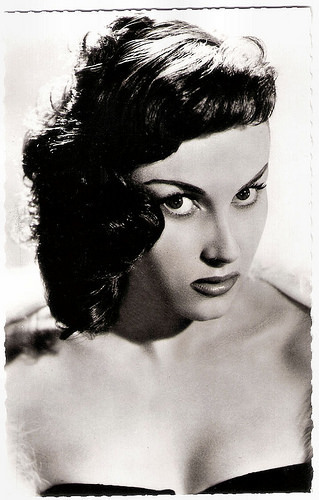
French postcard by Editions P.I., Paris, presented by Les Carbones Korès Carboplane, no. 813. Photo: Sam Lévin.
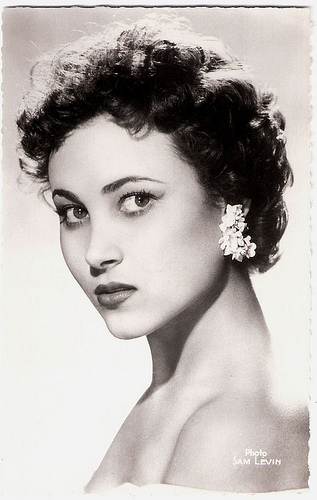
French postcard by Editions du Globe (E.D.U.G.), Paris, no. 466. Photo: Sam Lévin.
Hard Boiled Crime Film
Pascale Roberts was born in Boulogne-sur-Seine, France in 1933. Her mother was a director at Elisabeth Arden and among her clients were Martine Carol , Edwige Feuillère and Dora Doll.
Through Martine Carol , Pascale became an extra in Madame du Barry (Christian-Jaque, 1954). Pascale decided to go to acting classes in Paris, against the wishes of her mother. She had a small part in the comedy Une vie de garçon/A Boy’s Life (Jean Boyer, 1954) and a bit part as a girl at a poker game in the hard boiled crime film Les femmes s'en balancent/Dames Don’t Care (Bernard Borderie, 1954) starring Eddie Constantine as FBI agent Lemmy Caution.
Pascale Roberts would appear several times opposite Constantine such as in Ces dames préfèrent le mambo/Dishonorable Discharge (Bernard Borderie, 1957) as a femme fatale. She could also be seen in other film noirs such as Cherchez la femme/Look for the woman (Raoul André, 1955) with Pierre Mondy, and Dans la gueule du loup/In the Mouth of the Wolf (Jean-Charles Dudrumet, 1961) based on a crime novel by James Hadley Chase.
In 1957, she married Pierre Mondy but they divorced a few years later. After dozens of mediocre comedies and thrillers, Roberts was really remarkable as the victim in Costa-Gravas’ first film, the fast-moving and entertaining thriller Compartiment tueurs/The Sleeping Car Murder (Costa Gravas, 1965) starring Catherine Allégret and her mother Simone Signoret .
Hal Erickson writes at AllMovie : “During a Marseilles-to-Paris overnight train trip, a girl is found dead in a sleeping car. As Paris detective Yves Montand steps up his investigation, more and more passengers turn up murdered. The unlikely climax is the only sore point of this otherwise well-wrought mystery. Bereft of the politicizing of Costa-Gavras' later works, The Sleeping Car Murders exhibits the director's fondness for American ‘film noir’ thrillers.”
On television, Roberts was that same year a co-star of Geneviève Grad in the comedy series Chambre à louer/Room for rent (Jean-Pierre Desagnat, 1965), and she appeared on TV in another popular comedy series Les saintes chéries/The holy darlings (Jean Becker, 1965) starring Micheline Presle .
Later she featured with Jean-Claude Pascal in a daily soap opera, Le Temps de vivre et le temps d'aimer/Time To Live and Time To Love (Louis Grospierre, 1973).
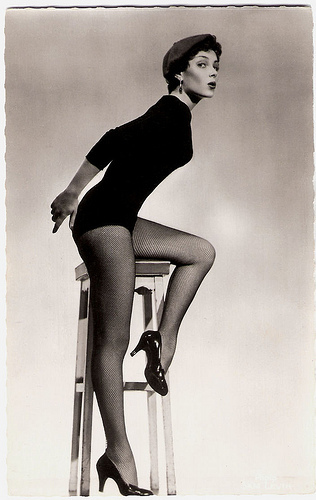
French postcard by Editions du Globe (E.D.U.G.), Paris, no. 467. Photo: Sam Lévin.
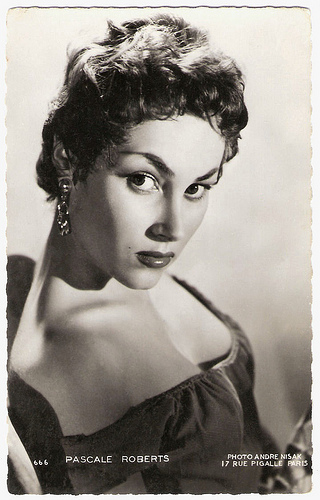
French postcard by Editions P.I., Paris, no. 666. Photo: Andre Nisak.
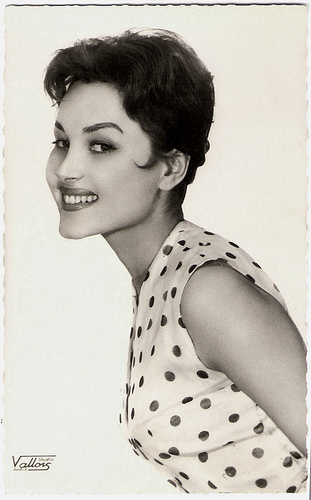
French postcard by Editions P.I., Paris, no. 924. Photo: Studio Vallois.
Urban Dramas
In 1975, Pascale Roberts played her arguably best known film role as the mother of rape and murder victim Isabelle Huppert in Dupont Lajoie/Rape of Innocence (Yves Boisset, 1975). This and her later roles were all supporting parts.
During the 1980s she appeared with Alain Delon in the Film Noir Trois hommes à abattre/Three Men to Destroy (Jacques Deray, 1980) and the policier Pour la peau d'un flic/For a Cop's Hide (Alain Delon, 1981), in which she played a junkie.
She also taught theatre at the École internationale de création audiovisuelle et de réalisation in Paris. Most of her later films are mediocre comedies and action films, but interesting were the delightful award-winning drama Le grand chemin/The Grand Highway (Jean-Loup Hubert, 1987) about the summer vacation of a high strung 9-year-old, the historical adventure La Fille de d'Artagnan/Revenge of the Musketeers (Bertrand Tavernier, 1994) starring Sophie Marceau , and the urban drama À la vie, à la mort!/'Til Death Do Us Part (Robert Guédiguian, 1995) about a family of Spanish immigrants in France featuring Ariane Ascaride.
Gradually Roberts had grown from femme fatale into mother roles. With the husband and wife team of Robert Guédiguian and Ariane Ascaride she worked again at Marius et Jeannette/Marius and Jeanette (Robert Guédiguian, 1997), a comedy-drama set in Marseille about a couple, which puts faith in love to get them through times of extreme poverty.
For her role in this box office hit in France she was nominated for the César for Best Supporting Actress. They continued their cooperation with the urban dramas À la place du coeur/In the space of the heart (Robert Guédiguian, 1998), La ville est tranquille/The Town is Quiet (Robert Guédiguian, 2000), Mon père est ingénieur/My Father is an Engineer (Robert Guédiguian, 2004) and Lady Jane (Robert Guédiguian, 2008).
Since 2008, Roberts appears in the successful TV series Plus belle la vie/More beautiful than life (2004-2011). Her character in the show, Wanda Legendre, also featured in the TV comedy Course contre la montre/Race against the clock (Roger Wielgus, 2011). Her most recent screen appearance was a guest part in the comedy series Working girls (2016).
Pascale Roberts was married to and divorced from Pierre Mondy, Pierre Rey and Michel Le Royer .
Leader Compartiment Tueurs (1966). Source: Michel8665 (YouTube).
Trailer Marius et Jeannette (1997). Source: Films Bonheur / Feel-Good Movies (YouTube).
Sources: James Travers (Films de France), Hal Erickson (AllMovie), Notre Cinema (French), Wikipedia (French) and .

French postcard by Editions P.I., Paris, presented by Les Carbones Korès Carboplane, no. 813. Photo: Sam Lévin.

French postcard by Editions du Globe (E.D.U.G.), Paris, no. 466. Photo: Sam Lévin.
Hard Boiled Crime Film
Pascale Roberts was born in Boulogne-sur-Seine, France in 1933. Her mother was a director at Elisabeth Arden and among her clients were Martine Carol , Edwige Feuillère and Dora Doll.
Through Martine Carol , Pascale became an extra in Madame du Barry (Christian-Jaque, 1954). Pascale decided to go to acting classes in Paris, against the wishes of her mother. She had a small part in the comedy Une vie de garçon/A Boy’s Life (Jean Boyer, 1954) and a bit part as a girl at a poker game in the hard boiled crime film Les femmes s'en balancent/Dames Don’t Care (Bernard Borderie, 1954) starring Eddie Constantine as FBI agent Lemmy Caution.
Pascale Roberts would appear several times opposite Constantine such as in Ces dames préfèrent le mambo/Dishonorable Discharge (Bernard Borderie, 1957) as a femme fatale. She could also be seen in other film noirs such as Cherchez la femme/Look for the woman (Raoul André, 1955) with Pierre Mondy, and Dans la gueule du loup/In the Mouth of the Wolf (Jean-Charles Dudrumet, 1961) based on a crime novel by James Hadley Chase.
In 1957, she married Pierre Mondy but they divorced a few years later. After dozens of mediocre comedies and thrillers, Roberts was really remarkable as the victim in Costa-Gravas’ first film, the fast-moving and entertaining thriller Compartiment tueurs/The Sleeping Car Murder (Costa Gravas, 1965) starring Catherine Allégret and her mother Simone Signoret .
Hal Erickson writes at AllMovie : “During a Marseilles-to-Paris overnight train trip, a girl is found dead in a sleeping car. As Paris detective Yves Montand steps up his investigation, more and more passengers turn up murdered. The unlikely climax is the only sore point of this otherwise well-wrought mystery. Bereft of the politicizing of Costa-Gavras' later works, The Sleeping Car Murders exhibits the director's fondness for American ‘film noir’ thrillers.”
On television, Roberts was that same year a co-star of Geneviève Grad in the comedy series Chambre à louer/Room for rent (Jean-Pierre Desagnat, 1965), and she appeared on TV in another popular comedy series Les saintes chéries/The holy darlings (Jean Becker, 1965) starring Micheline Presle .
Later she featured with Jean-Claude Pascal in a daily soap opera, Le Temps de vivre et le temps d'aimer/Time To Live and Time To Love (Louis Grospierre, 1973).

French postcard by Editions du Globe (E.D.U.G.), Paris, no. 467. Photo: Sam Lévin.

French postcard by Editions P.I., Paris, no. 666. Photo: Andre Nisak.

French postcard by Editions P.I., Paris, no. 924. Photo: Studio Vallois.
Urban Dramas
In 1975, Pascale Roberts played her arguably best known film role as the mother of rape and murder victim Isabelle Huppert in Dupont Lajoie/Rape of Innocence (Yves Boisset, 1975). This and her later roles were all supporting parts.
During the 1980s she appeared with Alain Delon in the Film Noir Trois hommes à abattre/Three Men to Destroy (Jacques Deray, 1980) and the policier Pour la peau d'un flic/For a Cop's Hide (Alain Delon, 1981), in which she played a junkie.
She also taught theatre at the École internationale de création audiovisuelle et de réalisation in Paris. Most of her later films are mediocre comedies and action films, but interesting were the delightful award-winning drama Le grand chemin/The Grand Highway (Jean-Loup Hubert, 1987) about the summer vacation of a high strung 9-year-old, the historical adventure La Fille de d'Artagnan/Revenge of the Musketeers (Bertrand Tavernier, 1994) starring Sophie Marceau , and the urban drama À la vie, à la mort!/'Til Death Do Us Part (Robert Guédiguian, 1995) about a family of Spanish immigrants in France featuring Ariane Ascaride.
Gradually Roberts had grown from femme fatale into mother roles. With the husband and wife team of Robert Guédiguian and Ariane Ascaride she worked again at Marius et Jeannette/Marius and Jeanette (Robert Guédiguian, 1997), a comedy-drama set in Marseille about a couple, which puts faith in love to get them through times of extreme poverty.
For her role in this box office hit in France she was nominated for the César for Best Supporting Actress. They continued their cooperation with the urban dramas À la place du coeur/In the space of the heart (Robert Guédiguian, 1998), La ville est tranquille/The Town is Quiet (Robert Guédiguian, 2000), Mon père est ingénieur/My Father is an Engineer (Robert Guédiguian, 2004) and Lady Jane (Robert Guédiguian, 2008).
Since 2008, Roberts appears in the successful TV series Plus belle la vie/More beautiful than life (2004-2011). Her character in the show, Wanda Legendre, also featured in the TV comedy Course contre la montre/Race against the clock (Roger Wielgus, 2011). Her most recent screen appearance was a guest part in the comedy series Working girls (2016).
Pascale Roberts was married to and divorced from Pierre Mondy, Pierre Rey and Michel Le Royer .
Leader Compartiment Tueurs (1966). Source: Michel8665 (YouTube).
Trailer Marius et Jeannette (1997). Source: Films Bonheur / Feel-Good Movies (YouTube).
Sources: James Travers (Films de France), Hal Erickson (AllMovie), Notre Cinema (French), Wikipedia (French) and .
Published on July 19, 2017 22:00
July 18, 2017
Martin Landau (1928-2017)
On 15 July 2017, American character actor Martin Landau (1928-2017) died. In the 1960s, he was popular for his role as the agent and master of disguise Rollin Hand on the TV series Mission: Impossible (1966-1969) and in 1994, he won an Oscar for his portrayal of Bela Lugosi in Tim Burton's Ed Wood. He was 89.
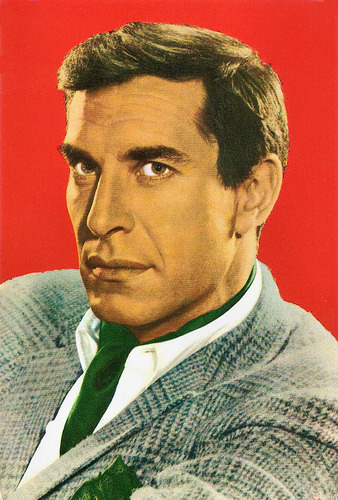
Spanish postcard by Ediciones Este, no. 181 T, 1967. Photo: publicity still for Mission: impossible (1966-1969).
Mission: Impossible
Martin Landau was born in 1928 in Brooklyn, New York. His parents were Majer Joel (Morris) Landau and Selma Buchman. At age 17, Martin was hired by the New York Daily News as a staff cartoonist and illustrator. In his five years on the paper, he served as the illustrator for Billy Rose's Pitching Horseshoes column. He also worked for cartoonist Gus Edson on The Gumps comic strip.
Landau's major ambition was to act, and in 1951, he made his stage debut in Detective Story in Peaks Island, Maine. He made his off-Broadway debut that year in First Love. Landau was one of 2000 applicants who auditioned for Lee Strasberg's Actors Studio in 1955 - only he and Steve McQueen were accepted. Landau was a friend of James Dean and McQueen, in a conversation with Landau, mentioned that he knew Dean and had met Landau. When Landau asked where they had met, McQueen informed him he had seen Landau riding into the New York City garage where he worked as a mechanic on the back of Dean's motorcycle.
He acted during the mid-1950s in such television anthologies as Omnibus (1955). He began making a name for himself after replacing star Franchot Tone in the 1956 off-Broadway revival of Anton Chekhov's Uncle Vanya, a famous production that helped put off-Broadway on the New York theatrical map. In 1957, he made a well-received Broadway debut in the play Middle of the Night. As part of the touring company with star Edward G. Robinson , he made it to the West Coast. He also guest-starred in such popular TV series as Maverick (1959), Sugarfoot (1958) and Rawhide (1959).
Martin Landau made his film debut in the war drama Pork Chop Hill (Lewis Milestone, 1959) with Gregory Peck. He scored in his second film as the heavy in Alfred Hitchcock's classic thriller North by Northwest (1959), in which he was shot on top of Mount Rushmore while sadistically stepping on the fingers of Cary Grant, who was holding on for dear life to the cliff face.
He also appeared in the blockbuster Cleopatra (Joseph L. Mankiewicz, 1963), the most expensive film ever made up to that time, which nearly scuttled 20th Century-Fox. It engendered one of the great public scandals, the Elizabeth Taylor - Richard Burton love affair that overshadowed the film itself. Landau's memorable portrayal in the key role of Rufio was highly favoured by the audience and instantly catapulted his popularity.
In 1963, Landau played memorable roles on two episodes of the science-fiction anthology series The Outer Limits (1963). He was Gene Roddenberry's first choice to play Mr. Spock on Star Trek (1966), but the role went to Leonard Nimoy, who later replaced Landau on Mission: Impossible (1966), the show that really made Landau famous. He originally was not meant to be a regular on the series, which co-starred his wife Barbara Bain, whom he had married in 1957.
His character, master impersonator Rollin Hand, was supposed to make occasional, though recurring appearances, but when the producers had problems with star Steven Hill, Landau was used to take up the slack. Rollin Hand was one of the specialists used by the Impossible Missions Force. Hand was described as a “man of a million faces”. Landau's characterisation was so well-received and so popular with the audience that he was made a regular. Landau received Emmy nominations as Outstanding Lead Actor in a Drama Series for each of the three seasons he appeared. In 1968, he won the Golden Globe award as Best Male TV Star.
Eventually, he quit the series in 1969 after a salary dispute when the new star, Peter Graves, was given a contract that paid him more than Landau, whose own contract stated he would have parity with any other actor on the show who made more than he did. The producers refused to budge and he and Bain, who had become the first actress in the history of television to be awarded three consecutive Emmy Awards (1967-1969) while on the show, left the series, ostensibly to pursue film careers. The move actually held back their careers, and Mission: Impossible went on for another four years with other actors.
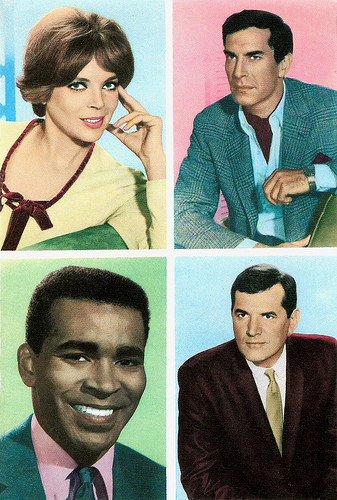
Spanish postcard by Ediciones Este, no. 182, 1967. Martin Landau, Steven Hill, Greg Morris and Barbara Bain were the original stars of the American action series Mission: Impossible (1966–1973), about an elite covert operations unit which carries out highly sensitive missions subject to official denial in the event of failure, death or capture.
Béla Lugosi
Martin Landau appeared in support of Sidney Poitier in They Call Me Mister Tibbs! (Norman Jewison, 1970), the less successful sequel to the Oscar-winning In the Heat of the Night (1967), but it did not generate more work of a similar caliber. He starred in the television movie Welcome Home, Johnny Bristol (George McCowan, 1972), playing a prisoner of war returning to the United States from Vietnam. The following year, he shot a pilot for a proposed show, Savage (1973). Though it was directed by emerging wunderkind Steven Spielberg, NBC did not pick up the show.
Needing work, Landau and Bain moved to England to play the leading roles in the syndicated science-fiction series Space: 1999 (1975-1977). In Europe Landau also appeared in the Giallo Una Magnum Special per Tony Saitta/Shadows in an Empty Room (Alberto De Martino, 1976) with Stuart Whitman and John Saxon . Landau's and Bain's careers stalled after Space: 1999 went out of production, and they were reduced to taking parts in the television movie The Harlem Globetrotters on Gilligan's Island (Peter Baldwin, 1981). It was the nadir of both their careers, and Bain's acting days, and their marriage, soon were over.
Landau, one of the most talented character actors in Hollywood, and one not without recognition, had bottomed out career-wise. In 1983, he was stuck in low-budget Sci-Fi and horror films like The Being (Jackie Kong, 1983), a role far beneath his talent. His career renaissance got off to a slow start with a recurring role in the NBC sitcom Buffalo Bill (1983), starring Dabney Coleman. On Broadway, he took over the title role in the revival of Dracula and went on the road with the national touring company. He also appeared in Raul Ruiz's Treasure Island (1985), a surrealistic modern-day riff on Robert Louis Stevenson's classic novel.
Finally, Martin Landau's career renaissance began to gather momentum when Francis Ford Coppola cast him in a critical supporting role in his Tucker: The Man and His Dream (1988), for which Landau was nominated for an Academy Award as Best Supporting Actor. He won his second Golden Globe for the role. The next year, he received his second consecutive Best Supporting Actor Oscar nomination for his superb turn as the adulterous husband in Woody Allen's Crimes and Misdemeanors (1989). He followed this up by playing famed Nazi hunter Simon Wiesenthal in the TNT movie Max and Helen (Philip Saville, 1990).
However, the summit of his post-Mission: Impossible career was about to be scaled. He portrayed as the horror actor Béla Lugosi in Tim Burton's biopic Ed Wood (1994) and won glowing reviews. Landau’s Lugosi is a tragicomic creation: his wife has left him, he is addicted to morphine and most of Hollywood thinks he is dead. For his performance, Landau won the Best Supporting Actor Oscar. He finally had been recognized with his profession's ultimate award. His performance, which also won him his third Golden Globe, garnered numerous awards in addition to the Oscar and Golden Globe, including top honors from the New York Film Critics Circle and the National Society of Film Critics.
Landau continued to play a wide variety of roles. In the United Kingdom he appeared opposite Michael Caine in the thriller Shiner (John Irvin, 2000). He turned in a superb performance in a supporting role in The Majestic (Frank Darabont, 2001) opposite Jim Carrey. He received his fourth Emmy nomination in 2004 as Outstanding Guest Actor in a Drama Series for Without a Trace (2002). Excellent was also his part as an Auschwitz survivor in Remember (Atom Egoyan, 2015).
Chris Wiegand in his obituary in The Guardian: "Landau’s own face was instantly recognisable, with its haunted eyes, wide mouth and furrowed brow; even when he broke into a smile, he could seem to be frowning." Martin Landau and Barbara Bain had two daughters, Susan Landau Finch and Juliet Landau.
Mini-Documentary on Mission: Impossible (2012). Source: Shatner Method (YouTube).
Trailer Ed Wood (1994). Source: Trailer Chan (YouTube).
Trailer Remember (2015). Source: moviemaniacsDE (YouTube).
Sources: Chris Wiegand (The Guardian), (IMDb), Wikipedia and .

Spanish postcard by Ediciones Este, no. 181 T, 1967. Photo: publicity still for Mission: impossible (1966-1969).
Mission: Impossible
Martin Landau was born in 1928 in Brooklyn, New York. His parents were Majer Joel (Morris) Landau and Selma Buchman. At age 17, Martin was hired by the New York Daily News as a staff cartoonist and illustrator. In his five years on the paper, he served as the illustrator for Billy Rose's Pitching Horseshoes column. He also worked for cartoonist Gus Edson on The Gumps comic strip.
Landau's major ambition was to act, and in 1951, he made his stage debut in Detective Story in Peaks Island, Maine. He made his off-Broadway debut that year in First Love. Landau was one of 2000 applicants who auditioned for Lee Strasberg's Actors Studio in 1955 - only he and Steve McQueen were accepted. Landau was a friend of James Dean and McQueen, in a conversation with Landau, mentioned that he knew Dean and had met Landau. When Landau asked where they had met, McQueen informed him he had seen Landau riding into the New York City garage where he worked as a mechanic on the back of Dean's motorcycle.
He acted during the mid-1950s in such television anthologies as Omnibus (1955). He began making a name for himself after replacing star Franchot Tone in the 1956 off-Broadway revival of Anton Chekhov's Uncle Vanya, a famous production that helped put off-Broadway on the New York theatrical map. In 1957, he made a well-received Broadway debut in the play Middle of the Night. As part of the touring company with star Edward G. Robinson , he made it to the West Coast. He also guest-starred in such popular TV series as Maverick (1959), Sugarfoot (1958) and Rawhide (1959).
Martin Landau made his film debut in the war drama Pork Chop Hill (Lewis Milestone, 1959) with Gregory Peck. He scored in his second film as the heavy in Alfred Hitchcock's classic thriller North by Northwest (1959), in which he was shot on top of Mount Rushmore while sadistically stepping on the fingers of Cary Grant, who was holding on for dear life to the cliff face.
He also appeared in the blockbuster Cleopatra (Joseph L. Mankiewicz, 1963), the most expensive film ever made up to that time, which nearly scuttled 20th Century-Fox. It engendered one of the great public scandals, the Elizabeth Taylor - Richard Burton love affair that overshadowed the film itself. Landau's memorable portrayal in the key role of Rufio was highly favoured by the audience and instantly catapulted his popularity.
In 1963, Landau played memorable roles on two episodes of the science-fiction anthology series The Outer Limits (1963). He was Gene Roddenberry's first choice to play Mr. Spock on Star Trek (1966), but the role went to Leonard Nimoy, who later replaced Landau on Mission: Impossible (1966), the show that really made Landau famous. He originally was not meant to be a regular on the series, which co-starred his wife Barbara Bain, whom he had married in 1957.
His character, master impersonator Rollin Hand, was supposed to make occasional, though recurring appearances, but when the producers had problems with star Steven Hill, Landau was used to take up the slack. Rollin Hand was one of the specialists used by the Impossible Missions Force. Hand was described as a “man of a million faces”. Landau's characterisation was so well-received and so popular with the audience that he was made a regular. Landau received Emmy nominations as Outstanding Lead Actor in a Drama Series for each of the three seasons he appeared. In 1968, he won the Golden Globe award as Best Male TV Star.
Eventually, he quit the series in 1969 after a salary dispute when the new star, Peter Graves, was given a contract that paid him more than Landau, whose own contract stated he would have parity with any other actor on the show who made more than he did. The producers refused to budge and he and Bain, who had become the first actress in the history of television to be awarded three consecutive Emmy Awards (1967-1969) while on the show, left the series, ostensibly to pursue film careers. The move actually held back their careers, and Mission: Impossible went on for another four years with other actors.

Spanish postcard by Ediciones Este, no. 182, 1967. Martin Landau, Steven Hill, Greg Morris and Barbara Bain were the original stars of the American action series Mission: Impossible (1966–1973), about an elite covert operations unit which carries out highly sensitive missions subject to official denial in the event of failure, death or capture.
Béla Lugosi
Martin Landau appeared in support of Sidney Poitier in They Call Me Mister Tibbs! (Norman Jewison, 1970), the less successful sequel to the Oscar-winning In the Heat of the Night (1967), but it did not generate more work of a similar caliber. He starred in the television movie Welcome Home, Johnny Bristol (George McCowan, 1972), playing a prisoner of war returning to the United States from Vietnam. The following year, he shot a pilot for a proposed show, Savage (1973). Though it was directed by emerging wunderkind Steven Spielberg, NBC did not pick up the show.
Needing work, Landau and Bain moved to England to play the leading roles in the syndicated science-fiction series Space: 1999 (1975-1977). In Europe Landau also appeared in the Giallo Una Magnum Special per Tony Saitta/Shadows in an Empty Room (Alberto De Martino, 1976) with Stuart Whitman and John Saxon . Landau's and Bain's careers stalled after Space: 1999 went out of production, and they were reduced to taking parts in the television movie The Harlem Globetrotters on Gilligan's Island (Peter Baldwin, 1981). It was the nadir of both their careers, and Bain's acting days, and their marriage, soon were over.
Landau, one of the most talented character actors in Hollywood, and one not without recognition, had bottomed out career-wise. In 1983, he was stuck in low-budget Sci-Fi and horror films like The Being (Jackie Kong, 1983), a role far beneath his talent. His career renaissance got off to a slow start with a recurring role in the NBC sitcom Buffalo Bill (1983), starring Dabney Coleman. On Broadway, he took over the title role in the revival of Dracula and went on the road with the national touring company. He also appeared in Raul Ruiz's Treasure Island (1985), a surrealistic modern-day riff on Robert Louis Stevenson's classic novel.
Finally, Martin Landau's career renaissance began to gather momentum when Francis Ford Coppola cast him in a critical supporting role in his Tucker: The Man and His Dream (1988), for which Landau was nominated for an Academy Award as Best Supporting Actor. He won his second Golden Globe for the role. The next year, he received his second consecutive Best Supporting Actor Oscar nomination for his superb turn as the adulterous husband in Woody Allen's Crimes and Misdemeanors (1989). He followed this up by playing famed Nazi hunter Simon Wiesenthal in the TNT movie Max and Helen (Philip Saville, 1990).
However, the summit of his post-Mission: Impossible career was about to be scaled. He portrayed as the horror actor Béla Lugosi in Tim Burton's biopic Ed Wood (1994) and won glowing reviews. Landau’s Lugosi is a tragicomic creation: his wife has left him, he is addicted to morphine and most of Hollywood thinks he is dead. For his performance, Landau won the Best Supporting Actor Oscar. He finally had been recognized with his profession's ultimate award. His performance, which also won him his third Golden Globe, garnered numerous awards in addition to the Oscar and Golden Globe, including top honors from the New York Film Critics Circle and the National Society of Film Critics.
Landau continued to play a wide variety of roles. In the United Kingdom he appeared opposite Michael Caine in the thriller Shiner (John Irvin, 2000). He turned in a superb performance in a supporting role in The Majestic (Frank Darabont, 2001) opposite Jim Carrey. He received his fourth Emmy nomination in 2004 as Outstanding Guest Actor in a Drama Series for Without a Trace (2002). Excellent was also his part as an Auschwitz survivor in Remember (Atom Egoyan, 2015).
Chris Wiegand in his obituary in The Guardian: "Landau’s own face was instantly recognisable, with its haunted eyes, wide mouth and furrowed brow; even when he broke into a smile, he could seem to be frowning." Martin Landau and Barbara Bain had two daughters, Susan Landau Finch and Juliet Landau.
Mini-Documentary on Mission: Impossible (2012). Source: Shatner Method (YouTube).
Trailer Ed Wood (1994). Source: Trailer Chan (YouTube).
Trailer Remember (2015). Source: moviemaniacsDE (YouTube).
Sources: Chris Wiegand (The Guardian), (IMDb), Wikipedia and .
Published on July 18, 2017 22:00
Paul van Yperen's Blog
- Paul van Yperen's profile
- 13 followers
Paul van Yperen isn't a Goodreads Author
(yet),
but they
do have a blog,
so here are some recent posts imported from
their feed.



